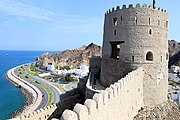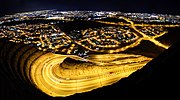Мой собственный
Султанат Оман Султанат Оман ( арабский ) | |
|---|---|
| Гимн: Королевский гимн мира. « ас-Салам ас-Султан » «Султанское приветствие» | |
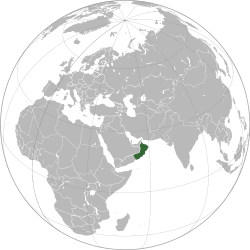 Расположение Омана (темно-зеленый) | |
| Капитал и крупнейший город | Маскат 23 ° 35'20 "N 58 ° 24'30" E / 23,58889 ° N 58,40833 ° E |
| Официальные языки | арабский [ 1 ] |
| Религия (2024) |
|
| Демон(ы) | Оманский |
| Правительство | Унитарная исламская абсолютная монархия |
• Султан | Хайсам бин Тарик |
| Тейзин бин Хайсам | |
| Законодательная власть | Совет Омана |
| Государственный совет (Маджлис ад-Даула) | |
| Консультативная ассамблея (Маджлис аш-Шура) | |
| Учреждение | |
• азд Миграция племени | 130 |
• Аль-Джуланда | 629 |
| 751 | |
| 1154 | |
| 1507–1656 | |
| 1624 | |
| 1744 | |
| 8 января 1856 г. | |
• Султанат Оман | 9 августа 1970 г. |
| 6 ноября 1996 г. (установлено); 2011 г. (с поправками); 2021 г. (с поправками) [ 4 ] | |
| Область | |
• Общий | 309 500 км 2 (119 500 квадратных миль) ( 70-е место ) |
• Вода (%) | незначительный |
| Population | |
• 2021 estimate | 4,520,471[5][6] (125th) |
• 2010 census | 2,773,479[7] |
• Density | 15/km2 (38.8/sq mi) (177th) |
| GDP (PPP) | 2023 estimate |
• Total | |
• Per capita | |
| GDP (nominal) | 2023 estimate |
• Total | |
• Per capita | |
| Gini (2018) | 30.75[9] medium |
| HDI (2022) | very high (59th) |
| Currency | Omani rial (OMR) |
| Time zone | UTC+4 (GST) |
| Date format | dd.mm.yyyy |
| Driving side | right |
| Calling code | +968 |
| ISO 3166 code | OM |
| Internet TLD | .om, عمان. |
Website www.oman.om | |
собственный , [ б ] официально Султанат Оман , [ с ] это страна в Аравии . Он расположен на юго-восточном побережье Аравийского полуострова и выходит на устье Персидского залива . Он имеет сухопутные границы с Саудовской Аравией , Объединенными Арабскими Эмиратами и Йеменом , а также морские границы с Ираном и Пакистаном . Столица и крупнейший город — Маскат . Население Омана составляет почти 4,7 миллиона человек. [ 11 ] и является 124-й по численности населения страной . Побережье обращено к Аравийскому морю на юго-востоке и Оманскому заливу на северо-востоке. Мадха (который он разделяет и Мусандам Эксклавы окружены Объединенными Арабскими Эмиратами на сухопутных границах, при этом Ормузский пролив с Ираном) и Оманский залив образуют прибрежные границы Мусандама.
С 17 века Оманский султанат представлял собой империю , соперничавшую с Португальской и Британской империями за влияние в Персидском заливе и Индийском океане. На пике своего развития в 19 веке влияние и контроль Омана распространялись через Ормузский пролив на Иран и Пакистан, а также на юг до Занзибара . [ 12 ] В 20 веке султанат попал под влияние Соединенного Королевства . На протяжении более 300 лет отношения, выстраиваемые между двумя империями, основывались на взаимной выгоде. Великобритания признала географическое значение Омана как торгового центра, который обеспечивал безопасность британских торговых путей в Персидском заливе и Индийском океане и защищал интересы Лондона на Индийском субконтиненте. Оман — абсолютная монархия во главе с султаном , власть передается по мужской линии. Кабус бин Саид был султаном с 1970 года до своей смерти 10 января 2020 года. [ 13 ] назвал своего двоюродного брата Хайсама бин Тарика своим преемником, и правящая семья утвердила его в качестве нового султана Омана. Кабус, который умер бездетным, в письме [ 14 ]
Бывшая морская империя, Оман является старейшим постоянно независимым государством в арабском мире . [ 15 ] [ 16 ] Она является членом Организации Объединенных Наций , Лиги арабских государств , Совета сотрудничества стран Персидского залива , Движения неприсоединения и Организации исламского сотрудничества . По запасам нефти страна занимает 22-е место в мире. [ 15 ] [ 17 ] В 2010 году Программа развития Организации Объединенных Наций оценила Оман как страну с самым высоким уровнем развития в мире за предыдущие 40 лет. [ 18 ] Часть его экономики связана с туризмом и торговлей рыбой, финиками и другой сельскохозяйственной продукцией. Всемирный банк относит Оман к странам с высокими доходами и по состоянию на 2023 г. [update] Оман занимает 48-е место в рейтинге самых миролюбивых стран мира Согласно Глобальному индексу миролюбия, . [ 19 ]
Этимология
[ редактировать ]Самое старое письменное упоминание об Омане было найдено в гробнице, расположенной в археологическом центре Млейха в Объединенных Арабских Эмиратах. [ 20 ] Считается, что происхождение названия Омана на несколько веков старше, чем упоминание Плинием Старшим. Омана [ 21 ] и Ὄμανον Оманон Птолемея ( ἐποριον по -гречески ), [ 22 ] оба, вероятно, древний Сохар . [ 23 ] Город или регион обычно этимологизируются на арабском языке от «амин» или «амун» («оседлые» люди, в отличие от бедуинов ). [ 23 ] Хотя было предложено несколько одноименных основателей (Оман бин Ибрагим аль-Халил, Оман бин Сиба бин Ягтан бин Ибрагим, Оман бин Кахтан), другие выводят его из названия долины в Йемене в Марибе, которая предположительно была происхождение основателей города, азд , племени, мигрировавшего из Йемена. [ 24 ]
История
[ редактировать ]Prehistory and ancient history
[edit]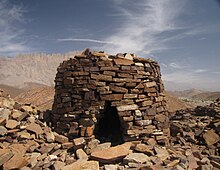
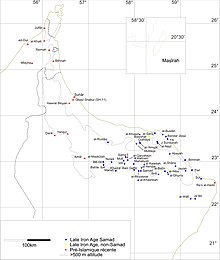
At Aybut Al Auwal, in the Dhofar Governorate of Oman, a site was discovered in 2011 containing more than 100 surface scatters of stone tools, belonging to a regionally specific African lithic industry—the late Nubian Complex—known previously only from the northeast and Horn of Africa. Two optically stimulated luminescence age estimates place the Arabian Nubian Complex at 106,000 years old. This supports the proposition that early human populations moved from Africa into Arabia during the Late Pleistocene.[25]
In recent years surveys have uncovered Palaeolithic and Neolithic sites on the eastern coast. Main Palaeolithic sites include Saiwan-Ghunaim in the Barr al-Hikman.[26] Archaeological remains are particularly numerous for the Bronze Age Umm an-Nar and Wadi Suq periods. At the archaeological sites of Bat, Al-Janah, and Al-Ayn wheel-turned pottery, hand-made stone vessels, metals industry artifacts, and monumental architecture have been preserved.[27]
There is considerable agreement in sources that frankincense was used by traders in 1500 BCE. The Land of Frankincense, a UNESCO World Heritage site, dramatically illustrates that the incense constituted testimony to South Arabian civilizations.
During the 8th century BCE, it is believed that the Yaarub, the descendant of Qahtan, ruled the entire region of Yemen, including Oman. Wathil bin Himyar bin Abd-Shams (Saba) bin Yashjub (Yaman) bin Yarub bin Qahtan later ruled Oman.[28] It is thus believed that the Yaarubah were the first settlers in Oman from Yemen.[29]
In the 1970s and 1980s, scholars like John C. Wilkinson[30] believed by virtue of oral history that in the 6th century BCE, the Achaemenids exerted control over the Omani peninsula, most likely ruling from a coastal centre such as Suhar.[31] Central Oman has its own indigenous Samad Late Iron Age cultural assemblage named eponymously from Samad al-Shan. In the northern part of the Oman Peninsula the Recent Pre-Islamic Period begins in the 3rd century BCE and extends into the 3rd century CE. Whether or not Persians brought south-eastern Arabia under their control is a moot point, since the lack of Persian archeological finds speak against this belief. Armand-Pierre Caussin de Perceval suggests that Shammir bin Wathil bin Himyar recognized the authority of Cyrus the Great over Oman in 536 BCE.[28]
Sumerian tablets referred to Oman as "Magan"[32][33] and in the Akkadian language "Makan",[34][35] a name which links Oman's ancient copper resources.[36]
Arab settlement
[edit]Over centuries tribes from western Arabia settled in Oman, making a living by fishing, farming, herding or stock breeding, and many present day Omani families trace their ancestral roots to other parts of Arabia. Arab migration to Oman started from northern-western and south-western Arabia and those who chose to settle had to compete with the indigenous population for the best arable land. When Arab tribes started to migrate to Oman, there were two distinct groups. One group, a segment of the Azd tribe migrated from Yemen in 120[37]/200 CE following the collapse of Marib Dam, while the other group migrated a few centuries before the birth of Islam from Nejd (present-day Saudi Arabia), named Nizari. Other historians believe that the Yaarubah from Qahtan which belong to an older branch, were the first settlers of Oman from Yemen, and then came the Azd.[29]

The Azd settlers in Oman are descendants of Nasr bin Azd and were later known as "the Al-Azd of Oman".[37] Seventy years after the first Azd migration, another branch of Alazdi under Malik bin Fahm, the founder of Kingdom of Tanukhites on the west of Euphrates, is believed to have settled in Oman.[37] According to Al-Kalbi, Malik bin Fahm was the first settler of Alazd.[38] He is said to have first settled in Qalhat. By this account, Malik, with an armed force of more than 6000 men and horses, fought against the Marzban, who served an ambiguously named Persian king in the battle of Salut in Oman and eventually defeated the Persian forces.[29][39][40][41] This account is, however, semi-legendary and seems to condense multiple centuries of migration and conflict as well as an amalgamation of various traditions from not only the Arab tribes but also the region's original inhabitants.[39][42][43]
In the 7th century CE, Omanis came in contact with and accepted Islam.[44][45] The conversion of Omanis to Islam is ascribed to Amr ibn al-As, who was sent by the prophet Muhammad during the Expedition of Zaid ibn Haritha (Hisma). Amer was dispatched to meet with Jaifer and Abd, the sons of Julanda who ruled Oman. They appear to have readily embraced Islam.[46]
Imamate of Oman
[edit]Omani Azd used to travel to Basra for trade, which was a centre of Islam, during the Umayyad empire. Omani Azd were granted a section of Basra, where they could settle and attend to their needs. Many of the Omani Azd who settled in Basra became wealthy merchants and, under their leader Muhallab bin Abi Sufrah, started to expand their influence of power eastwards towards Khorasan. Ibadhi Islam originated in Basra through its founder, Abdullah ibn Ibadh, around the year 650 CE; the Omani Azd in Iraq would subsequently adopt this as their predominant faith. Later, Al-hajjaj, the governor of Iraq, came into conflict with the Ibadhis, which forced them back to Oman. Among those who returned was the scholar Jaber bin Zaid. His return (and the return of many other scholars) greatly enhanced the Ibadhi movement in Oman.[47] Alhajjaj also made an attempt to subjugate Oman, then ruled by Suleiman and Said (the sons of Abbad bin Julanda). Alhajjaj dispatched Mujjaah bin Shiwah, who was confronted by Said bin Abbad. This confrontation devastated Said's army, after which he and his forces retreated to the Jebel Akhdar (mountains). Mujjaah and his forces went after Said, successfully flushing them out from hiding in Wadi Mastall. Mujjaah later moved towards the coast, where he confronted Suleiman bin Abbad. The battle was won by Suleiman's forces. Alhajjaj, however, sent another force (under Abdulrahman bin Suleiman); he eventually won the war, taking over the governance of Oman.[48][49][50]
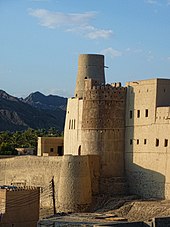
The first elective Imamate of Oman is believed to have been established shortly after the fall of the Umayyad Dynasty in 750/755 CE, when Janaħ bin ʕibadah Alħinnawi was elected.[47][51] Other scholars claim that Janaħ bin Ibadah served as a Wāli (governor) under the Umayyad dynasty (and later ratified the Imamate), and that Julanda bin Masud was the first elected Imam of Oman, in 751 CE.[52][53] The first Imamate reached its peak power in the ninth century CE.[47] The Imamate established a maritime empire whose fleet controlled the Gulf, during the time when trade with the Abbasid Dynasty, the Far East, and Africa flourished.[54] The authority of the Imams started to decline due to power struggles, the constant interventions of Abbasid, and the rise of the Seljuk Empire.[55][52]
Nabhani dynasty
[edit]During the 11th and 12th centuries, the Omani coast was in the sphere of influence of the Seljuk Empire. They were expelled in 1154, when the Nabhani dynasty came to power.[55] The Nabhanis ruled as muluk, or kings, while the Imams were reduced to largely symbolic significance. The capital of the dynasty was Bahla.[56] The Banu Nabhan controlled the trade in frankincense on the overland route via Sohar to the Yabrin oasis, and then north to Bahrain, Baghdad and Damascus.[57] The mango-tree was introduced to Oman during the time of Nabhani dynasty, by ElFellah bin Muhsin.[29][58] The Nabhani dynasty started to deteriorate in 1507 when Portuguese colonisers captured the coastal city of Muscat, and gradually extended their control along the coast up to Sohar in the north and down to Sur in the southeast.[59] Other historians argue that the Nabhani dynasty ended earlier in 1435 CE when conflicts between the dynasty and Alhinawis arose, which led to the restoration of the elective Imamate.[29]
Portuguese era
[edit]
A decade after Vasco da Gama succeeded in his voyage around the Cape of Good Hope and to India in 1497–1498, the Portuguese arrived in Oman and occupied Muscat for a 143-year period, from 1507 to 1650. In need of an outpost to protect their sea lanes, the Portuguese built up and fortified the city. Remnants of Portuguese architectural style still exist. Later, several more Omani cities were colonized in the early 16th century by the Portuguese, to control the entrances of the Persian Gulf and trade in the region as part of a web of fortresses in the region, from Basra to Hormuz Island.
However, in 1552 an Ottoman fleet briefly captured the fort in Muscat, during their fight for control of the Persian Gulf and the Indian Ocean, but soon departed after destroying the surroundings of the fortress.[60]
Later in the 17th century, using its bases in Oman, Portugal engaged in the largest naval battle ever fought in the Persian Gulf. The Portuguese force fought against a combined armada of the Dutch East India Company (VOC) and English East India Company supported by the Safavid empire. The result of the battle was a draw but it resulted in the loss of Portuguese influence in the Gulf.[61]
Yaruba dynasty (1624–1744)
[edit]
The Ottoman Empire temporarily captured Muscat from the Portuguese again in 1581 and held it until 1588. During the 17th century, the Omanis were reunited by the Yaruba Imams. Nasir bin Murshid became the first Yaarubah Imam in 1624, when he was elected in Rustaq.[63] Imam Nasir and his successor succeeded in the 1650s in expelling the Portuguese from their coastal domains in Oman.[47] The Omanis over time established a maritime empire that pursued the Portuguese and expelled them from all their possessions in East Africa, which were then incorporated into the Omani domains. To capture Zanzibar Saif bin Sultan, the Imam of Oman, pressed down the Swahili Coast. A major obstacle to his progress was Fort Jesus, housing the garrison of a Portuguese settlement at Mombasa. After a two-year siege, the fort fell to Imam Saif bin Sultan in 1698. Saif bin Sultan occupied Bahrain in 1700. The rivalry within the house of Yaruba over power after the death of Imam Sultan in 1718 weakened the dynasty. With the power of the Yaruba Dynasty dwindling, Imam Saif bin Sultan II eventually asked for help against his rivals from Nader Shah of Persia. A Persian force arrived in March 1737 to aid Saif. From their base at Julfar, the Persian forces eventually rebelled against the Yaruba in 1743. The Persian empire then tried to take possession of the coast of Oman until 1747.[47][64]
18th and 19th centuries
[edit]
After the Omanis expelled the Persians, Ahmed bin Sa'id Albusaidi became the elected Imam of Oman in 1749, with Rustaq serving as the capital. Since the revival of the Imamate with the Yaruba dynasty, the Omanis continued with the elective system but, provided that the person is deemed qualified, gave preference to a member of the ruling family.[65] Following Imam Ahmed's death in 1783, his son, Said bin Ahmed became the elected Imam. His son, Seyyid Hamed bin Said, overthrew the representative of his father the Imam in Muscat and obtained the possession of Muscat fortress. Hamed ruled as "Seyyid". Afterwards, Seyyid Sultan bin Ahmed, the uncle of Seyyid Hamed, took over power. Seyyid Said bin Sultan succeeded Sultan bin Ahmed.[66][67] During the entire 19th century, in addition to Imam Said bin Ahmed who retained the title until he died in 1803, Azzan bin Qais was the only elected Imam of Oman. His rule started in 1868. However, the British refused to accept Imam Azzan as a ruler, as he was viewed as inimical to their interests. This view played an instrumental role in supporting the deposition of Imam Azzan in 1871 by his cousin, Sayyid Turki, a son of the late Sayyid Said bin Sultan, and brother of Sultan Barghash of Zanzibar, who Britain deemed to be more acceptable.[68]
Oman's Imam Sultan, defeated ruler of Muscat, was granted sovereignty over Gwadar, an area of modern-day Pakistan.[note 1][69]
British de facto colonisation
[edit]The British empire was keen to dominate southeast Arabia to stifle the growing power of other European states and to curb the Omani maritime power that grew during the 17th century.[70][54] The British empire over time, starting from the late 18th century, began to establish a series of treaties with the sultans with the objective of advancing British political and economic interest in Muscat, while granting the sultans military protection.[54][70] In 1798, the first treaty between the British East India Company and the Albusaidi dynasty was signed by Sayyid Sultan bin Ahmed. The treaty aimed to block commercial competition of the French and the Dutch as well as obtain a concession to build a British factory at Bandar Abbas.[71][47][72] A second treaty was signed in 1800, which stipulated that a British representative shall reside at the port of Muscat and manage all external affairs with other states.[72] As the Omani Empire weakened, the British influence over Muscat grew throughout the nineteenth century.[62]
In 1854, a deed of cession of the Omani Kuria Muria islands to Britain was signed by the sultan of Muscat and the British government.[74] The British government achieved predominating control over Muscat, which, for the most part, impeded competition from other nations.[75] Between 1862 and 1892, the Political Residents, Lewis Pelly and Edward Ross, played an instrumental role in securing British supremacy over the Persian Gulf and Muscat by a system of indirect governance.[68] By the end of the 19th century, and with the loss of its African dominions and its revenues, British influence increased to the point that the sultans became heavily dependent on British loans and signed declarations to consult the British government on all important matters.[70][76][77][78] The Sultanate thus came de facto under the British sphere.[77][79]
Zanzibar was a valuable property as the main slave market of the Swahili Coast as well as being a major producer of cloves, and became an increasingly important part of the Omani empire, a fact reflected by the decision of the Sayyid Sa'id bin Sultan, to make it the capital of the empire in 1837. In 1856, under British arbitration, Zanzibar and Muscat became two different sultanates.[80]
Treaty of Seeb
[edit]
The Hajar Mountains, of which the Jebel Akhdar is a part, separate the country into two distinct regions: the interior, and the coastal area dominated by the capital, Muscat.[citation needed] The British imperial development over Muscat and Oman during the 19th century led to the renewed revival of the cause of the Imamate in the interior of Oman, which has appeared in cycles for more than 1,200 years in Oman.[54] The British Political Agent, who resided in Muscat, owed the alienation of the interior of Oman to the vast influence of the British government over Muscat, which he described as being completely self-interested and without any regard to the social and political conditions of the locals.[81] In 1913, Imam Salim Alkharusi instigated an anti-Muscat rebellion that lasted until 1920 when the Sultanate established peace with the Imamate by signing the Treaty of Seeb. The treaty was brokered by Britain, which had no economic interest in the interior of Oman during that point of time. The treaty granted autonomous rule to the Imamate in the interior of Oman and recognized the sovereignty of the coast of Oman, the Sultanate of Muscat.[70][82][83][84] In 1920, Imam Salim Alkharusi died and Muhammad Alkhalili was elected.[47]
On 10 January 1923, an agreement between the Sultanate and the British government was signed in which the Sultanate had to consult with the British political agent residing in Muscat and obtain the approval of the High Government of India to extract oil in the Sultanate.[85] On 31 July 1928, the Red Line Agreement was signed between Anglo-Persian Company (later renamed British Petroleum), Royal Dutch/Shell, Compagnie Française des Pétroles (later renamed Total), Near East Development Corporation (later renamed ExxonMobil) and Calouste Gulbenkian (an Armenian businessman) to collectively produce oil in the post-Ottoman Empire region, which included the Arabian peninsula, with each of the four major companies holding 23.75 percent of the shares while Calouste Gulbenkian held the remaining 5 percent shares. The agreement stipulated that none of the signatories was allowed to pursue the establishment of oil concessions within the agreed on area without including all other stakeholders. In 1929, the members of the agreement established Iraq Petroleum Company (IPC).[86] On 13 November 1931, Sultan Taimur bin Faisal abdicated.[87]
Reign of Sultan Said (1932–1970)
[edit]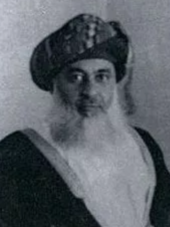
Said bin Taimur became the sultan of Muscat officially on 10 February 1932. The rule of sultan Said, a very complex character, was backed by the British government, and has been characterised as being feudal, reactionary and isolationist.[84][54][77][88] The British government maintained vast administrative control over the Sultanate as the defence secretary and chief of intelligence, chief adviser to the sultan and all ministers except for two were British.[77][89] In 1937, an agreement between the sultan and Iraq Petroleum Company (IPC), a consortium of oil companies that was 23.75% British owned, was signed to grant oil concessions to IPC. After failing to discover oil in the Sultanate, IPC was intensely interested in some promising geological formations near Fahud, an area located within the Imamate. IPC offered financial support to the sultan to raise an armed force against any potential resistance by the Imamate.[90][91]
Upon the outbreak of World War II, the sultan of Oman declared war on Germany on September 10, 1939.[92] During the war, Oman had a strategic role in the defence of the United Kingdom's trade routes. Oman was never attacked during the war. In 1943, the Royal Air Force established stations on Masirah Island (RAF Masirah) and at Ras al Hadd. Air-sea rescue units were also stationed in Oman. No. 244 Squadron RAF flew Bristol Blenheim V light bombers and Vickers Wellington XIIIs out of RAF Masirah on anti-submarine duties in the Gulf of Oman and the northern Arabian Sea, while No. 209 Squadron RAF, No. 265 Squadron RAF, and No. 321 Squadron RAF flew Consolidated PBY Catalinas out of Umm Ruşayş on Masirah Island.[93] On October 16, 1943, the German U-Boat U-533 was sunk in the Gulf of Oman after being struck by depth charges dropped by a Bristol Blenheim from No. 244 Squadron RAF. The wreck settled at a depth of 108 meters (354 feet) approximately 25 nautical miles (46 kilometres) off the Fujairah coast. 52 crew members died, with the sole survivor, Matrosengefreiter Günther Schmidt, taken aboard HMIS Hiravati near Khor Fakkan and made a prisoner of war. The wreck is now a popular recreational diving site.[94][95]
The December 1951 Treaty of Friendship, Commerce and Navigation (covering commerce, oil reserves and navigation) between Oman and the United Kingdom recognized the Sultanate of Muscat and Oman as a fully independent state.
In 1955, the exclave coastal Makran strip acceded to Pakistan and was made a district of its Balochistan province, while Gwadar remained in Oman. On 8 September 1958, Pakistan purchased the Gwadar enclave from Oman for US$3 million.[note 2][96] Gwadar then became a tehsil in the Makran district.
Jebel Akhdar War
[edit]Sultan Said bin Taimur expressed his interest in occupying the Imamate right after the death of Imam Alkhalili, thus taking advantage of any potential instability that might occur within the Imamate when elections were due, to the British government.[97] The British political agent in Muscat believed that the only method of gaining access to the oil reserves in the interior was by assisting the sultan in taking over the Imamate.[98] In 1946, the British government offered arms and ammunition, auxiliary supplies and officers to prepare the sultan to attack the interior of Oman.[99] In May 1954, Imam Alkhalili died and Ghalib Alhinai was elected Imam.[100] Relations between the Sultan Said bin Taimur, and Imam Ghalib Alhinai frayed over their dispute about oil concessions.
In December 1955, Sultan Said bin Taimur sent troops of the Muscat and Oman Field Force to occupy the main centres in Oman, including Nizwa, the capital of the Imamate of Oman, and Ibri.[82][101] The Omanis in the interior led by Imam Ghalib Alhinai, Talib Alhinai, the brother of the Imam and the Wali (governor) of Rustaq, and Suleiman bin Hamyar, who was the Wali (governor) of Jebel Akhdar, defended the Imamate in the Jebel Akhdar War against British-backed attacks by the Sultanate. In July 1957, the Sultan's forces were withdrawing, but they were repeatedly ambushed, sustaining heavy casualties.[82] Sultan Said, however, with the intervention of British infantry (two companies of the Cameronians), armoured car detachments from the British Army and RAF aircraft, was able to suppress the rebellion.[102] The Imamate's forces retreated to the inaccessible Jebel Akhdar.[102][90]
Colonel David Smiley, who had been seconded to organise the Sultan's Armed Forces, managed to isolate the mountain in autumn 1958 and found a route to the plateau from Wadi Bani Kharus.[103] On 4 August 1957, the British Foreign Secretary gave the approval to carry out air strikes without prior warning to the locals residing in the interior of Oman.[88] Between July and December 1958, the British RAF made 1,635 raids, dropping 1,094 tons and firing 900 rockets at the interior of Oman targeting insurgents, mountain top villages, water channels and crops.[77][88] On 27 January 1959, the Sultanate's forces occupied the mountain in a surprise operation.[103] Imam Ghalib, his brother Talib and Sulaiman managed to escape to Saudi Arabia, where the Imamate's cause was promoted until the 1970s.[103] The exiled partisans of the now abolished Imamate of Oman presented the case of Oman to the Arab League and the United Nations.[104][105] On 11 December 1963, the UN General Assembly decided to establish an Ad-Hoc Committee on Oman to study the 'Question of Oman' and report back to the General Assembly.[106] The UN General Assembly adopted the 'Question of Oman' resolution in 1965, 1966 and again in 1967 that called upon the British government to cease all repressive action against the locals, end British control over Oman and reaffirmed the inalienable right of the Omani people to self-determination and independence.[107][108][79][109][110][111]
Dhofar War
[edit]In the Dhofar War, which began in 1963, pro-Soviet forces were pitted against government troops. As the rebellion threatened the Sultan's control of Dhofar, Sultan Said bin Taimur was deposed in a bloodless coup in 1970 by his son Qaboos bin Said with British support. Qaboos expanded the Sultan of Oman's Armed Forces, modernized the state's administration and introduced social reforms. The uprising was finally put down in 1976 with the help of forces from Jordan, Saudi Arabia, Iran, Pakistan and Britain.
Modern history (1970–present)
[edit]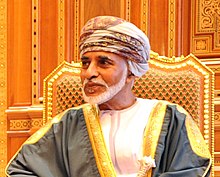
After deposing his father in 1970, Sultan Qaboos opened up the country, removed "Muscat and" from the country's name, embarked on economic reforms, and followed a policy of modernisation marked by increased spending on health, education and welfare.[112] Saudi Arabia invested in the development of the Omani education system, sending Saudi teachers on its own expense.[113][114] Slavery, once a cornerstone of the country's trade and development, was outlawed in 1970.[115]
In 1971, Oman joined the United Nations, as did Bahrain, Qatar and the United Arab Emirates.
In 1981, Oman became a founding member of the six-nation Gulf Cooperation Council. Political reforms were eventually introduced. The country adopted its present national flag in 1995, resembling the previous flag but with a thicker stripe. In 1997, a royal decree was issued granting women the right to vote, and stand for election to the Majlis al-Shura, the Consultative Assembly of Oman. Two women were duly elected to the body. In 2002, voting rights were extended to all citizens over the age of 21, and the first elections to the Consultative Assembly under the new rules were held in 2003. In 2004, the Sultan appointed Oman's first female minister with portfolio, Sheikha Aisha bint Khalfan bin Jameel al-Sayabiyah, to the post of National Authority for Industrial Craftsmanship.[116] Despite these changes, there was little change to the actual political makeup of the government. The Sultan continued to rule by decree. Nearly 100 suspected Islamists were arrested in 2005 and 31 people were convicted of trying to overthrow the government. They were ultimately pardoned in June of the same year.[15]
Before the Beijing Olympics, Oman became the stop of the Middle East's torch relay on 14 April 2008, covering 20 kilometres.
Inspired by the Arab Spring uprisings that were taking place throughout the region, protests occurred in Oman during the early months of 2011. While they did not call for the ousting of the regime, demonstrators demanded political reforms, improved living conditions and the creation of more jobs. They were dispersed by riot police in February 2011. Sultan Qaboos reacted by promising jobs and benefits. In October 2011, elections were held to the Consultative Assembly, to which Sultan Qaboos promised greater powers. The following year, the government began a crackdown on internet criticism. In September 2012, trials began of 'activists' accused of posting "abusive and provocative" criticism of the government online. Six were given jail terms.[117]
In 2013, Oman achieved its status as the elimination of malaria diagnoses, according to the World Health Organization.
Qaboos, the Arab world's longest-serving ruler, died on 10 January 2020.[118] Leaving no heir on succession, on 11 January 2020 Qaboos was succeeded by his first cousin Haitham bin Tariq.[119]
On 12 January 2021, Dhi Yazan bin Haitham, Sultan Haithan's oldest son became the crown prince as first in line to succeed his father under new fundamental law.
Geography
[edit]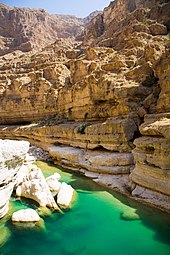

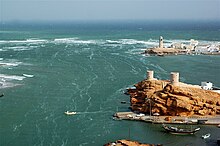
Oman lies between latitudes 16th parallel north and 28th parallel north, and longitudes 52nd meridian east and 60th meridian east. A gravel desert plain covers most of central Oman, with mountain ranges along the north (Hajar Mountains) and southeast coast (Dhofar Mountains),[120][121] where the country's main cities are located: the capital city Muscat, Sohar and Sur in the north, and Salalah in the south and Musandam. Oman's climate is hot and dry in the interior and humid along the coast.
The peninsula of Musandam (Musandem), strategically located on the Strait of Hormuz, is an exclave separated from the rest of Oman by the United Arab Emirates.[122]
Madha, another exclave, is an enclave within UAE territory located halfway between the Musandam Peninsula and the main body of Oman.[122] Madha, part of the Musandam governorate, covers approximately 75 square kilometres (29 sq mi). Madha's boundary was settled in 1969, with the north-east corner of Madha barely 10 metres (33 ft) from the Fujairah road. Within the Madha exclave is a UAE enclave called Nahwa, belonging to the Emirate of Sharjah, situated about 8 kilometres (5.0 mi) west of the town of New Madha, and consisting of about forty houses with a clinic and telephone exchange.[123]
The central desert of Oman is a source of meteorites for scientific analysis.[124]
Climate
[edit]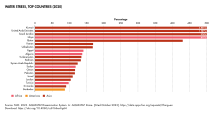
Like the rest of the Persian Gulf, Oman generally has one of the hottest climates in the world—with summer temperatures in Muscat and northern Oman averaging 30 to 40 °C (86.0 to 104.0 °F).[125] Oman receives little rainfall, with annual rainfall in Muscat averaging 100 mm (3.9 in), occurring mostly in January. In the south, the Dhofar Mountains area near Salalah has a tropical-like climate and receives seasonal rainfall from late June to late September as a result of monsoon winds from the Indian Ocean, leaving the summer air saturated with cool moisture and heavy fog.[126] Summer temperatures in Salalah range from 20 to 30 °C (68.0 to 86.0 °F)—relatively cool compared to northern Oman.[127]
The mountain areas receive more rainfall, and annual rainfall on the higher parts of the Jabal Akhdar probably exceeds 400 millimetres (16 in).[128] Low temperatures in the mountainous areas leads to snow cover once every few years.[129] Some parts of the coast, particularly near the island of Masirah, sometimes receive no rain at all within the course of a year. The climate is generally very hot, with temperatures reaching around 54 °C (129.2 °F) (peak) in the hot season, from May to September.[130]
On 26 June 2018 the city of Qurayyat set the record for highest minimum temperature in a 24-hour period, 42.6°C (108.7°F).[131]
In terms of climate action, major challenges remain to be solved, per the United Nations Sustainable Development 2019 index. The CO2 emissions from energy (tCO2/capita) and CO2 emissions embodied in fossil fuel exports (kg per capita) rates are very high, while imported CO2 emissions (tCO2/capita) and people affected by climate-related disasters (per 100,000 people) rates are low.[132]
Biodiversity
[edit]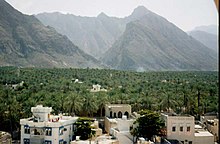

Desert shrub and desert grass, common to southern Arabia, are found in Oman, but vegetation is sparse in the interior plateau, which is largely gravel desert. The greater monsoon rainfall in Dhofar and the mountains makes the growth there more luxuriant during summer; coconut palms grow plentifully on the coastal plains of Dhofar and frankincense is produced in the hills, with abundant oleander and varieties of acacia. The Hajar Mountains are a distinct ecoregion, the highest points in eastern Arabia with wildlife including the Arabian tahr.

Indigenous mammals include the leopard, hyena, fox, wolf, hare, oryx and ibex. Birds include the vulture, eagle, stork, bustard, Arabian partridge, bee eater, falcon and sunbird. In 2001, Oman had nine endangered species of mammals, five endangered types of birds,[133] and nineteen threatened plant species. Decrees have been passed to protect endangered species, including the Arabian leopard, Arabian oryx, mountain gazelle, goitered gazelle, Arabian tahr, green sea turtle, hawksbill turtle and olive ridley turtle. However, the Arabian Oryx Sanctuary is the first site ever to be deleted from UNESCO's World Heritage List, following the government's 2007 decision to reduce the site's area by 90% to clear the way for oil prospectors.[134]
Local and national entities have noted unethical treatment of animals in Oman. In particular, stray dogs (and to a lesser extent, stray cats) are often the victims of torture, abuse or neglect.[135] The only approved method of decreasing the stray dog population is shooting by police officers. The Oman government has refused to implement a spay and neuter programme or create any animal shelters in the country. Cats, while seen as more acceptable than dogs, are viewed as pests and frequently die of starvation or illness.[136][137]
In recent years, Oman has become one of the newer hot spots for whale watching, highlighting the critically endangered Arabian humpback whale, sperm whales and pygmy blue whales.[138]
Politics
[edit]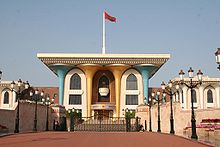
Oman is a unitary state and an absolute monarchy,[139] in which all legislative, executive and judiciary power ultimately rests in the hands of the hereditary Sultan. Consequently, Freedom House has routinely rated the country "Not Free".[140]
The sultan is the head of state and directly controls the foreign affairs and defence portfolios.[141] He has absolute power and issues laws by decree.[142][143]
Legal system
[edit]Oman is an absolute monarchy, with the Sultan's word having the force of law. The judiciary branch is subordinate to the Sultan. According to Oman's constitution, Sharia law is one of the sources of legislation. Sharia court departments within the civil court system are responsible for family-law matters, such as divorce and inheritance.
While ultimate power is concentrated in the Sultan[13] and Oman does not have an official separation of powers,[13] the late Sultan Qaboos declined to grant the full title Minister of Defence, Minister of Foreign Affairs and Minister of Finance to the ministers exercising those responsibilities, preferring to keep them within the Royal Domain. The current Sultan Haitham has granted the ministers responsible of those portfolios the full titles, whilst elevating the defense portfolio to that of a deputy prime minister.[13] Since 1970 all legislation has been promulgated through royal decrees, including the 1996 Basic Law.[13] The Sultan appoints the ministers, the judges, and can grant pardons and commute sentences.[13] The Sultan's authority is inviolable and the Sultan expects total subordination to his will.[13]
The administration of justice is highly personalized, with limited due process protections, especially in political and security-related cases.[144] The Basic Statute of the State[145] is supposedly the cornerstone of the Omani legal system and it operates as a constitution for the country. The Basic Statute was issued in 1996 and thus far has only been amended twice: in 2011,[146] in response to protests; and in 2021, to create the position of Crown Prince of Oman.
Though Oman's legal code theoretically protects civil liberties and personal freedoms, both are regularly ignored by the regime.[13] Women and children face legal discrimination in many areas.[13] Women are excluded from certain state benefits, such as housing loans, and are refused equal rights under the personal status law.[13] Women also experience restrictions on their self-determination in respect to health and reproductive rights.[13]
The Omani legislature is the bicameral Council of Oman, consisting of an upper chamber, the Council of State (Majlis ad-Dawlah) and a lower chamber, the Consultative Assembly (Majlis al-Shura).[147] Political parties are banned, as are any affiliations based on religion.[143] The upper chamber has 71 members, appointed by the Sultan from among prominent Omanis; it has only advisory powers.[148] The 84 members of the Consultative Assembly are elected by universal suffrage to serve four-year terms.[148] The members are appointed for three-year terms, which may be renewed once.[147] The last elections were held on 29 October 2023, and the next is due in October 2027. Oman's national anthem, As-Salam as-Sultani is dedicated to former Sultan Qaboos.
Foreign policy
[edit]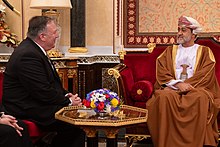
Since 1970, Oman has pursued a moderate foreign policy, and has expanded its diplomatic relations dramatically. Oman is among the very few Arab countries that have maintained friendly ties with Iran.[149][150] Yusuf bin Alawi bin Abdullah is the Sultanate's Minister Responsible for Foreign Affairs.
Oman allowed the British Royal Navy and Indian Navy access to the port facilities of Al Duqm Port & Drydock.[151]
Military
[edit]
SIPRI's estimation of Oman's military and security expenditure as a percentage of GDP in 2020 was 11 percent, making it the world's highest rate in that year, higher than Saudi Arabia (8.4 percent).[152] Oman's on-average military spending as a percentage of GDP between 2016 and 2018 was around 10 percent, while the world's average during the same period was 2.2 percent.[153]
Oman's military manpower totalled 44,100 in 2006, including 25,000 men in the army, 4,200 sailors in the navy, and an air force with 4,100 personnel. The Royal Household maintained 5,000 Guards, 1,000 in Special Forces, 150 sailors in the Royal Yacht fleet, and 250 pilots and ground personnel in the Royal Flight squadrons. Oman also maintains a modestly sized paramilitary force of 4,400 men.[154]
The Royal Army of Oman had 25,000 active personnel in 2006, plus a small contingent of Royal Household troops. Despite a comparative large military spending, it has been relatively slow to modernise its forces. Oman has a relatively limited number of tanks, including 6 M60A1, 73 M60A3 and 38 Challenger 2 main battle tanks, as well as 37 aging Scorpion light tanks.[154]
The Royal Air Force of Oman has approximately 4,100 men, with 36 combat aircraft and no armed helicopters. Combat aircraft include 20 aging Jaguars, 12 Hawk Mk 203s, 4 Hawk Mk 103s and 12 PC-9 turboprop trainers with a limited combat capability. It has one squadron of 12 F-16C/D aircraft. Oman also has 4 A202-18 Bravos and 8 MFI-17B Mushshaqs.[154]
The Royal Navy of Oman had 4,200 men in 2000, and is headquartered at Seeb. It has bases at Ahwi, Ghanam Island, Mussandam and Salalah. In 2006, Oman had ten surface combat vessels. These included two 1,450-ton Qahir class corvettes, and eight ocean-going patrol boats. The Omani Navy had one 2,500-ton Nasr al Bahr class LSL (240 troops, 7 tanks) with a helicopter deck. Oman also had at least four landing craft.[154] Oman ordered three Khareef class corvettes from the VT Group for £400 million in 2007. They were built at Portsmouth.[155] In 2010 Oman spent US$4.074 billion on military expenditures, 8.5% of the gross domestic product.[156] The sultanate has a long history of association with the British military and defence industry.[157] According to SIPRI, Oman was the 23rd largest arms importer from 2012 to 2016.[158]
Human rights
[edit]Torture methods in use in Oman include mock execution, beating, hooding, solitary confinement, subjection to extremes of temperature and to constant noise, abuse and humiliation.[159][160] There have been numerous reports of torture and other inhumane forms of punishment perpetrated by Omani security forces on protesters and detainees.[161] Several prisoners detained in 2012 complained of sleep deprivation, extreme temperatures and solitary confinement.[162] Homosexuality is criminalised within Oman.[163]

The Omani government decides who can or cannot be a journalist and this permission can be withdrawn at any time.[165] Censorship and self-censorship are a constant factor.[165] Omanis have limited access to political information through the media.[166] Access to news and information can be problematic: journalists have to be content with news compiled by the official news agency on some issues.[165] Through a decree by the Sultan, the government has now extended its control over the media to blogs and other websites.[165] Omanis cannot hold a public meeting without the government's approval.[165] Omanis who want to set up a non-governmental organisation of any kind need a licence.[165] The Omani government does not permit the formation of independent civil society associations.[161] Human Rights Watch issued in 2016, that an Omani court sentenced three journalists to prison and ordered the permanent closure of their newspaper, over an article that alleged corruption in the judiciary.[167]
Omani law prohibits criticism of the Sultan and government in any form or medium.[165] Oman's police do not need search warrants to enter people's homes.[165] The law does not provide citizens with the right to change their government.[165] The Sultan retains ultimate authority on all foreign and domestic issues.[165] Government officials are not subject to financial disclosure laws.[165] Criticism of government figures and politically objectionable views have been suppressed.[165] Publication of books is limited and the government restricts their importation and distribution, as with other media products.[165]
Until 2023, Omani citizens needed government permission to marry foreigners.[162] In April 2023 the law was changed by a royal decree, allowing Omani citizens to marry foreigners without government permission.[168] According to HRW, women in Oman face discrimination.[164]
The plight of domestic workers in Oman is a taboo subject.[169][170] In 2011, the Philippines government determined that out of all the countries in the Middle East, only Oman and Israel qualify as safe for Filipino migrants.[171][170] Migrant workers remained insufficiently protected against exploitation.[172]
Administrative divisions
[edit]
The Sultanate is administratively divided into eleven governorates. Governorates are, in turn, divided into 60 wilayats.[173][174]
- Ad Dakhiliyah
- Ad Dhahirah
- Al Batinah North
- Al Batinah South
- Al Buraimi
- Al Wusta
- Ash Sharqiyah North
- Ash Sharqiyah South
- Dhofar
- Muscat
- Musandam
Economy
[edit]
Oman's Basic Statute of the State expresses in Article 11 that the "national economy is based on justice and the principles of a free economy".[175] By regional standards, Oman has a relatively diversified economy, but remains dependent on oil exports. In terms of monetary value, mineral fuels accounted for 82.2 percent of total product exports in 2018.[176] Tourism is the fastest-growing industry in Oman. Other sources of income, agriculture and industry, are small in comparison and account for less than 1% of the country's exports, but diversification is seen as a priority by the government. Agriculture, often subsistence in its character, produces dates, limes, grains and vegetables, but with less than 1% of the country under cultivation, Oman is likely to remain a net importer of food.
Oman's socio-economic structure is described as being hyper-centralized rentier welfare state.[177] The largest 10 percent of corporations in Oman are the employers of almost 80 percent of Omani nationals in the private sector. Half of the private sector jobs are classified as elementary. One third of employed Omanis are in the private sector, while the remaining majority are in the public sector.[178] A hyper-centralized structure produces a monopoly-like economy, which hinders having a healthy competitive environment between businesses.[177]
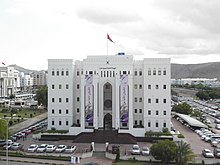
Since a slump in oil prices in 1998, Oman has made active plans to diversify its economy and is placing a greater emphasis on other areas of industry, namely tourism and infrastructure. Oman had a 2020 Vision to diversify the economy established in 1995, which targeted a decrease in oil's share to less than 10 percent of GDP by 2020, but it was rendered obsolete in 2011. Oman then established 2040 Vision.[177] A free-trade agreement with the United States took effect 1 January 2009, eliminated tariff barriers on all consumer and industrial products, and also provided strong protections for foreign businesses investing in Oman.[179] Tourism, another source of Oman's revenue, is on the rise.[180]
Foreign Direct Investment (FDI) in Oman by country as of 2017[181]
Oman's foreign workers send an estimated US$10 billion annually to their home states in Asia and Africa, more than half of them earning a monthly wage of less than US$400.[182] The largest foreign community is from the Indian states of Kerala, Tamil Nadu, Karnataka, Maharashtra, Gujarat and the Punjab,[183] representing more than half of entire workforce in Oman. Salaries for overseas workers are known to be less than for Omani nationals, though still from two to five times higher than for the equivalent job in India.[182]
In terms of foreign direct investment (FDI), total investments in 2017 exceeded US$24 billion. The highest share of FDI went to the oil and gas sector, which represented around US$13billion (54.2 percent), followed by financial intermediation, which represented US$3.66 billion (15.3 percent). FDI is dominated by the United Kingdom with an estimated value of US$11.56billion (48 percent), followed by the UAE US$2.6 billion (10.8 percent), followed by Kuwait US$1.1 billion (4.6 percent).[181]
Oman in 2018 had a budget deficit of 32 percent of total revenue and a government debt to GDP of 47.5 percent.[184][185] Oman's military spending to GDP between 2016 and 2018 averaged 10 percent, while the world's average during the same period was 2.2 percent.[186] Oman's health spending to GDP between 2015 and 2016 averaged 4.3 percent, while the world's average during the same period was 10 percent.[187] Oman's research and development spending between 2016 and 2017 averaged 0.24 percent, which is significantly lower than the world's average (2.2 percent) during the same period.[188] Oman's government spending on education to GDP in 2016 was 6.11 percent, while the world's average was 4.8 percent (2015).[189]
| Type | Spending (% of GDP)[190][191][192][193] |
|---|---|
| Military spending | |
| Education spending | |
| Health spending | |
| Research & Development spending |
Oil and gas
[edit]
Oman's proved reserves of petroleum total about 5.5 billion barrels, 25th largest in the world.[149] Oil is extracted and processed by Petroleum Development Oman (PDO), with proven oil reserves holding approximately steady, although oil production has been declining.[194][195] The Ministry of Energy and Minerals is responsible for all oil and gas infrastructure and projects in Oman.[196] Following the 1970s energy crisis, Oman doubled their oil output between 1979 and 1985.[197]
In 2018, oil and gas represented 71 percent of the government's revenues.[184] In 2016, oil and gas share of the government's revenue represented 72 percent.[198] The government's reliance on oil and gas as a source of income dropped by 1 percent from 2016 to 2018. Oil and gas sector represented 30.1 percent of the nominal GDP in 2017.[199]
Between 2000 and 2007, production fell by more than 26%, from 972,000 to 714,800 barrels per day.[200] Production has recovered to 816,000 barrels in 2009, and 930,000 barrels per day in 2012.[200] Oman's natural gas reserves are estimated at 849.5 billion cubic metres, ranking 28th in the world, and production in 2008 was about 24 billion cubic metres per year.[149]
In September 2019, Oman was confirmed to become the first Middle Eastern country to host the International Gas Union Research Conference (IGRC 2020). This 16th iteration of the event will be held between 24 and 26 February 2020, in collaboration with Oman LNG, under the auspices of the Ministry of Energy and Minerals.[201]
Industry, innovation and infrastructure
[edit]In industry, innovation and infrastructure, Oman is still faced with "significant challenges", as per United Nations Sustainable Development Goals index, as of 2019. Oman has scored high on the rates of internet use, mobile broadband subscriptions, logistics performance and on the average of top 3 university rankings. Meanwhile, Oman scored low on the rate of scientific and technical publications and on research & development spending.[132] Oman's manufacturing value added to GDP rate in 2016 was 8.4 percent, which is lower than the average in the Arab world (9.8 percent) and world average (15.6 percent). In terms of research & development expenditures to GDP, Oman's share was on average 0.20 percent between 2011 and 2015, while the world's average during the same period was 2.11 percent.[202] The majority of firms in Oman operate in the oil and gas, construction and trade sectors.[203]
| Non-hydrocarbon GDP growth | 2015 | 2016 | 2017 | 2018 |
|---|---|---|---|---|
| Value (%)[204] | 4.8 | 6.2 | 0.5 | 1.5 |
Oman is refurbishing and expanding the ports infrastructure in Muscat, Duqm, Sohar and Salalah to expand tourism, local production and export shares. Oman is also expanding its downstream operations by constructing a refinery and petrochemical plant in Duqm with a 230,000 barrels per day capacity projected for completion by 2021.[181] The majority of industrial activity in Oman takes place in 8 industrial states and 4 free-zones. The industrial activity is mainly focused on mining-and-services, petrochemicals and construction materials.[203] The largest employers in the private-sector are the construction, wholesale-and-retail and manufacturing sectors, respectively. Construction accounts for nearly 48 percent of the total labour force, followed by wholesale-and-retail, which accounts for around 15 percent of total employment and manufacturing, which accounts for around 12 percent of employment in the private sector. The percentage of Omanis employed in the construction and manufacturing sectors is nevertheless low, as of 2011 statistics.[178]
Oman, as per Global Innovation Index (2019) report, scores "below expectations" in innovation relative to countries classified under high income.[205] Oman in 2019 ranked 80 out of 129 countries in innovation index, which takes into consideration factors, such as, political environment, education, infrastructure and business sophistication.[206] Innovation, technology-based growth and economic diversification are hindered by an economic growth that relies on infrastructure expansion, which heavily depends on a high percentage of 'low-skilled' and 'low-wage' foreign labour. Another challenge to innovation is the Dutch disease phenomenon, which creates an oil and gas investment lock-in, while relying heavily on imported products and services in other sectors. Such a locked-in system hinders local business growth and global competitiveness in other sectors, and thus impedes economic diversification.[203] The inefficiencies and bottlenecks in business operations that are a result of heavy dependence on natural resources and 'addiction' to imports in Oman suggest a 'factor-driven economy'.[178] A third hindrance to innovation in Oman is an economic structure that is heavily dependent on few large firms, while granting few opportunities for SMEs to enter the market, which impedes healthy market-share competition between firms.[203] The ratio of patent applications per million people was 0.35 in 2016 and the MENA region average was 1.50, while the 'high-income' countries' average was approximately 48.0 during the same year.[207] Oman was ranked 69th in the Global Innovation Index in 2023.[208]
Agriculture and fishing
[edit]Oman's fishing industry contributed 0.78 percent to the GDP in 2016. Fish exports between 2000 and 2016 grew from US$144 million to US$172 million (+19.4 percent). The main importer of Omani fish in 2016 was Vietnam, which imported almost US$80 million (46.5 percent) in value, and the second biggest importer was the United Arab Emirates, which imported around US$26 million (15 percent). The other main importers are Saudi Arabia, Brazil and China. Oman's consumption of fish is almost two times the world's average. The ratio of exported fish to total fish captured in tons fluctuated between 49 and 61 percent between 2006 and 2016. Omani strengths in the fishing industry comes from having a good market system, a long coastline (3,165 km) and wide water area. Oman, on the other hand, lacks sufficient infrastructure, research and development, quality and safety monitoring, together with a limited contribution by the fishing industry to GDP.[209]
Dates represent 80 percent of all fruit crop production. Further, date farms employ 50 percent of the total agricultural area in the country. Oman's estimated production of dates in 2016 is 350,000 tons, making it the 9th largest producer of dates. Oman's total export of dates was US$12.6 million in 2016, almost equivalent to Oman's total imported value of dates, which was US$11.3 million in 2016. The main importer is India (around 60 percent of all imports). Oman's date exports remained steady between 2006 and 2016. Oman is considered to have good infrastructure for date production and support provision to cultivation and marketing, but lacks innovation in farming and cultivation, industrial coordination in the supply chain and encounter high losses of unused dates.[209]
Tourism
[edit]
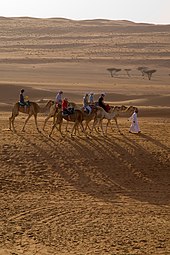
Tourism in Oman has grown considerably recently, and it is expected to be one of the largest industries in the country.[210] The World Travel & Tourism Council stated that Oman is the fastest growing tourism destination in the Middle East.[211]
Tourism contributed 2.8 percent to the Omani GDP in 2016. It grew from RO 505 million (US$1.3 billion) in 2009 to RO 719 million (US$1.8 billion) in 2017 (+42.3 percent growth). Citizens of the Gulf Cooperation Council (GCC), including Omanis who are residing outside of Oman, represent the highest ratio of all tourists visiting Oman, estimated to be 48 percent. The second highest number of visitors come from other Asian countries, who account for 17 percent of the total number of visitors.[209] A challenge to tourism development in Oman is the reliance on the government-owned firm, Omran, as a key actor to develop the tourism sector, which potentially creates a market barrier-to-entry of private-sector actors and a crowding out effect. Another key issue to the tourism sector is deepening the understanding of the ecosystem and biodiversity in Oman to guarantee their protection and preservation.[203]
Oman has one of the most diverse environments in the Middle East with various tourist attractions and is particularly well known for adventure and cultural tourism.[180][212] Muscat, the capital of Oman, was named the second best city to visit in the world in 2012 by the travel guide publisher Lonely Planet.[213] Muscat also was chosen as the Capital of Arab Tourism of 2012.[214]
In November 2019, Oman made the rule of visa on arrival an exception and introduced the concept of e-visa for tourists from all nationalities. Under the new laws, visitors were required to apply for the visa in advance.[215]
Demographics
[edit]| Year | Pop. | ±% p.a. |
|---|---|---|
| 1950 | 457,000 | — |
| 1960 | 537,000 | +1.63% |
| 1970 | 671,000 | +2.25% |
| 1980 | 1,017,000 | +4.25% |
| 1990 | 1,805,000 | +5.90% |
| 2000 | 2,344,000 | +2.65% |
| 2010 | 2,882,000 | +2.09% |
| 2015 | 4,192,000 | +7.78% |
| 2020 | 4,543,000 | +1.62% |
| 2023 | 4,644,384 | +0.74% |
| source:[5][6] | ||
By 2020, Oman's population exceeded 4.5 million.[216] The total fertility rate in 2020 was estimated to be 2.8 children born per woman; this rate has been rapidly decreasing in recent years.[217] About half of the population lives in Muscat and the Batinah coastal plain northwest of the capital. Omanis are predominantly of Arab, Baluchi and African origins.[149] Around 20 percent of Omanis are of Baloch descent whose ancestors migrated to Oman centuries ago, and are now considered native.[218]
Omani society is largely tribal[219][220][221] and encompasses three major identities:[219] that of the tribe, the Ibadi faith and maritime trade.[219] The first two identities are closely tied to tradition and are especially prevalent in the interior of the country, owing to lengthy periods of isolation.[219] The third identity pertains mostly to Muscat and the coastal areas of Oman, and is reflected by business, trade,[219] and the diverse origins of many Omanis, who trace their roots to Baloch, Al-Lawatia, Persia and historical Omani Zanzibar.[222] Gwadar, a region of Balochistan, was a Colony of Oman for more than a century and in the 1960s, Pakistan took over the land. Many people in this area are Omani and Pakistani.[223]
Religion
[edit]Even though the Oman government does not keep statistics on religious affiliation, statistics from the US's Central Intelligence Agency state that adherents of Islam are in the majority at 85.9 percent, while 6.4 percent are Christians, 5.7 percent Hindus, 0.8 percent Buddhists, and fewer than 0.1 percent are Jews; members of other religious affiliations comprise 1 percent and the unaffiliated 0.2 percent.
Most Omanis are Muslims; these predominantly follow the Ibadi[225] school of Islam, followed by the Twelver school of Shia Islam, and the Shafi`i school of Sunni Islam. Virtually all non-Muslims in Oman are foreign workers. Non-Muslim religious communities include various groups of Jains, Buddhists, Zoroastrians, Sikhs, Hindus and Christians. Christian communities are centred in the major urban areas of Muscat, Sohar and Salalah. These include Catholic, Eastern Orthodox and various Protestant congregations, organising along linguistic and ethnic lines. More than 50 different Christian groups, fellowships and assemblies are active in the Muscat metropolitan area, formed by migrant workers from Southeast Asia.
There are also communities of ethnic Indian Hindus and Christians. There are also a small Sikh[226] community.
Languages
[edit]
Arabic is the official language of Oman. It belongs to the Semitic branch of the Afroasiatic family.[175] There are several dialects of Arabic spoken, all part of the Peninsular Arabic family: Dhofari Arabic (also known as Dhofari, Zofari) is spoken in Salalah and the surrounding coastal regions (the Dhofar Governorate);[227] Gulf Arabic is spoken in parts bordering the UAE; whereas Omani Arabic, distinct from the Gulf Arabic of eastern Arabia and Bahrain, is spoken in Central Oman, although with recent oil wealth and mobility has spread over other parts of the Sultanate.
According to the CIA, besides Arabic, English, Baluchi (Southern Baluchi), Urdu, Tamil, Bengali (spoken by Indians and Bangladeshis), Hindi, Malayalam, Tulu and various other Indian languages are the main languages spoken in Oman.[149] English is widely spoken in the business community and is taught at school from an early age. Almost all signs and writings appear in both Arabic and English at tourist sites.[180] Baluchi is the mother tongue of the Baloch people from Balochistan in western Pakistan, eastern Iran and southern Afghanistan. It is also used by some descendants of Sindhi sailors.[228] Bengali is widely spoken due to a large Bangladeshi expatriate population. A significant number of residents also speak Urdu, due to the influx of Pakistani migrants during the late 1980s and 1990s. Additionally, Swahili is widely spoken in the country due to the historical relations between Oman and Zanzibar.[12]
Today the Mehri language is limited in its distribution to the area around Salalah, in Zafar and westward into the Yemen. But until the 18th or 19th century it was spoken further north, perhaps into Central Oman.[229] Baluchi (Southern Baluchi) is widely spoken in Oman.[230] Endangered indigenous languages in Oman include Kumzari, Bathari, Harsusi, Hobyot, Jibbali and Mehri.[231] Omani Sign Language is the language of the deaf community.
Education
[edit]
Oman scored high as of 2019 on the percentage of students who complete lower secondary school and on the literacy rate between the age of 15 and 24, 99.7 percent and 98.7 percent, respectively. However, Oman's net primary school enrollment rate in 2019, which is 94.1 percent, is rated as "challenges remain" by the United Nations Sustainable Development Goals (UNSDG) standard. Oman's overall evaluation in quality of education, according to UNSDG, is 94.8 ("challenges remain") as of 2019.[132]
Oman's higher education produces a surplus in humanities and liberal arts, while it produces an insufficient number in technical and scientific fields and required skill-sets to meet the market demand.[203] Further, sufficient human capital creates a business environment that can compete with, partner or attract foreign firms. Accreditation standards and mechanisms with a quality control that focuses on input assessments, rather than output, are areas of improvement in Oman, according to the United Nations Conference on Trade and Development 2014 report.[203] The transformation Index BTI 2018 report on Oman recommends that the education curriculum should focus more on the "promotion of personal initiative and critical perspective".[177] Oman was ranked 84th in the Global Innovation Index in 2020, down from 80th in 2019.[232][233][234][235]
The adult literacy rate in 2010 was 86.9 percent.[236]
According to the Webometrics Ranking of World Universities, the top-ranking universities in the country are Sultan Qaboos University (1678th worldwide), Dhofar University (6011th) and the University of Nizwa (6093rd).[237]
Healthcare
[edit]Since 2003, Oman's undernourished share of the population has dropped from 11.7 percent to 5.4 percent in 2016, but the rate remains high: double the level of high-income economies (2.7 percent) in 2016.[238] The UNSDG targets zero hunger by 2030.[239] Oman's coverage of essential health services in 2015 was 77 percent, which is relatively higher than the world's average of approximately 54 percent during the same year, but lower than high-income economies' level (83 percent) in 2015.[240]
Since 1995, the percentage of Omani children who receive key vaccines has consistently been very high (above 99 percent). As for road incident death rates, Oman's rate has been decreasing since 1990, from 98.9 per 100,000 individuals to 47.1 per 100,000 in 2017, however, the rate remains significantly above average, which was 15.8 per 100,000 in 2017.[241] Oman's health spending to GDP between 2015 and 2016 averaged 4.3 percent, while the world's average during the same period averaged 10 percent.[187]
As for mortality due to air pollution (household and ambient air pollution), Oman's rate was 53.9 per 100,000 population as of 2016.[242] However, in 2019 the World Health Organization (WHO) ranked Oman as the least polluted country in the Arab world, with a score of 37.7 in the pollution index. The country ranked 112th in Asia among the list of highest polluted countries.[243]
Life expectancy at birth in Oman was estimated to be 76.1 years in 2010.[244] As of 2010[update], there were an estimated 2.1 physicians and 2.1 hospital beds per 1,000 people.[244] In 1993, 89 percent of the population had access to health care services. In 2000, 99 percent of the population had access to health care services.[245] In 2000, Oman's health system was ranked number 8 by the World Health Organization.[246]
Largest cities
[edit]| Rank | Name | Governorate / Region | Pop. | ||||||
|---|---|---|---|---|---|---|---|---|---|
 Muscat  Seeb |
1 | Muscat | Muscat | 797,000 |  Salalah  Bawshar | ||||
| 2 | Seeb | Muscat | 237,816 | ||||||
| 3 | Salalah | Dhofar | 163,140 | ||||||
| 4 | Bawshar | Muscat | 159,487 | ||||||
| 5 | Sohar | Al Batinah | 108,274 | ||||||
| 6 | Suwayq | Al Batinah | 107,143 | ||||||
| 7 | Ibri | Az Zahirah | 101,640 | ||||||
| 8 | Saham | Al Batinah | 89,327 | ||||||
| 9 | Barka | Al Batinah | 81,647 | ||||||
| 10 | Rustaq | Al Batinah | 79,383 | ||||||
Culture
[edit]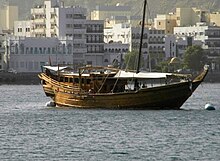
Outwardly, Oman shares many of the cultural characteristics of its Arab neighbours, particularly those in the Gulf Cooperation Council.[248] Despite these similarities, important factors make Oman unique in the Middle East.[248] These result as much from geography and history as from culture and economics.[248] The relatively recent and artificial nature of the state in Oman makes it difficult to describe a national culture;[248] however, sufficient cultural heterogeneity exists within its national boundaries to make Oman distinct from other Arab States of the Persian Gulf.[248] Oman's cultural diversity is greater than that of its Arab neighbours, given its historical expansion to the Swahili Coast and the Indian Ocean.[248]
Oman has a long tradition of shipbuilding, as maritime travel played a major role in the Omanis' ability to stay in contact with the civilisations of the ancient world. Sur was one of the most famous shipbuilding cities of the Indian Ocean. An al Ghanja ship takes one whole year to build. Other types of Omani ship include As Sunbouq and Al Badan.[249]
Dress
[edit]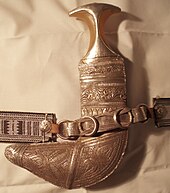
The male national dress in Oman consists of the dishdasha, a simple, ankle-length, collarless gown with long sleeves.[250] Most frequently white in colour, the dishdasha may also appear in a variety of other colours. Its main adornment, a tassel (furakha) sewn into the neckline, can be impregnated with perfume.[251] Underneath the dishdasha, men wear a plain, wide strip of cloth wrapped around the body from the waist down. The most noted regional differences in dishdasha designs are the style with which they are embroidered, which varies according to age group.[250] On formal occasions a black or beige cloak called a bisht may cover the dishdasha. The embroidery edging the cloak is often in silver or gold thread and it is intricate in detail.[251]
Omani men wear two types of headdress:
- the ghutra, also called "Musar" a square piece of woven wool or cotton fabric of a single colour, decorated with various embroidered patterns.
- the kummah, a cap that is the head dress worn during leisure hours.[250]
Some men carry the assa, a stick, which can have practical uses or is simply used as an accessory during formal events. Omani men, on the whole, wear sandals on their feet.[251]
The Janbiya (dagger) forms part of the national dress and men wear the Janbiya on all formal public occasions and festivals.[250] It is traditionally worn at the waist. Sheaths may vary from simple covers to ornate silver or gold-decorated pieces.[251] A depiction of a Janbiya appears on the national flag.[250]
Omani women wear eye-catching national costumes, with distinctive regional variations. All costumes incorporate vivid colours and vibrant embroidery and decorations. The Omani women's traditional costume comprises several garments: the kandoorah, which is a long tunic whose sleeves or radoon are adorned with hand-stitched embroidery of various designs. The dishdasha is worn over a pair of loose-fitting trousers, tight at the ankles, known as a sirwal. Women also wear a head shawl most commonly referred to as the lihaf.[252]
As of 2014[update] women reserve wearing their traditional dress for special occasions, and instead wear a loose black cloak called an abaya over their personal choice of clothing, whilst in some regions, particularly amongst the Bedouin, the burqa is still worn.[252] Women wear hijab, and though some women cover their faces and hands, most do not. The Sultan has forbidden the covering of faces in public office.[247]
Music and cinema
[edit]Music of Oman is extremely diverse due to Oman's imperial legacy. There are over 130 different forms of traditional Omani songs and dances. The Oman Centre for Traditional Music was established in 1984 to preserve them.[253] In 1985, Sultan Qaboos founded the Royal Oman Symphony Orchestra. Instead of engaging foreign musicians, he decided to establish an orchestra made up of Omanis.[254] On 1 July 1987 at the Al Bustan Palace Hotel's Oman Auditorium the Royal Oman Symphony Orchestra gave its inaugural concert.[255] In popular music, a seven-minute music video about Oman went viral, achieving 500,000 views on YouTube within 10 days of being released on YouTube in November 2015. The a cappella production features three of the region's most popular talents: Kahliji musician Al Wasmi, Omani poet Mazin Al-Haddabi and actress Buthaina Al Raisi.[256]
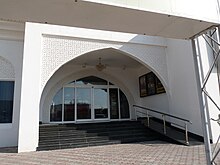
The cinema of Oman is very small, there being only one Omani film Al-Boom (2006) as of 2007[update]. Oman Arab Cinema Company LLC is the single largest motion picture exhibitor chain in Oman.[257]
Media
[edit]The government has continuously held a monopoly on television in Oman. Oman TV is the only state-owned national television channel broadcaster in Oman. Oman TV broadcasts four HD channels, including Oman TV General, Oman TV Sport, Oman TV Live and Oman TV Cultural.[258] Although private ownership of radio and television stations is permitted, Oman has only one privately owned television channel.[259] Majan TV is the first private TV channel in Oman. It began broadcasting in January 2009. However, Majan TV's official channel website was last updated in early 2010.[260] The public has access to foreign broadcasts since the use of satellite receivers is allowed.[259][261]
Oman Radio is the first and only state-owned radio channel.[259] It began broadcasting on 30 July 1970.[262] It operates both Arabic and English networks. Other private channels include Hala FM, Hi FM, Al-Wisal, Virgin Radio Oman FM and Merge. In early 2018, Muscat Media Group (MMG) launched a new private radio station.[263][264][265]
Oman has nine main newspapers, five in Arabic and four in English.[266]
The media landscape in Oman has been continuously described as restrictive, censored, and subdued.[267] The Ministry of Information censors politically, culturally, or sexually offensive material in domestic or foreign media. The press freedom group Reporters Without Borders ranked the country 127th out of 180 countries on its 2018 World Press Freedom Index. In 2016, the government drew international criticism for suspending the newspaper Azamn and arresting three journalists after a report on corruption in the country's judiciary. Azamn was not allowed to reopen in 2017 although an appeal court ruled in late 2016 that the paper can resume operating.[268]
Art
[edit]Traditional art in Oman stems from its long heritage of material culture. Art movements in the 20th century reveal that the art scene in Oman began with early practices that included a range of tribal handicrafts and self-portraiture in painting since the 1960s.[269] However, since the inclusion of several Omani artists in international collections, art exhibitions, and events, such Alia Al Farsi, the first Omani artist to show at the last Venice Biennale and Radhika Khimji, the first Omani artist to exhibit at both the Marrakesh and Haiti Ghetto biennale, Oman's position as a newcomer to the contemporary art scene in recent years has been more important for Oman's international exposure.[270]
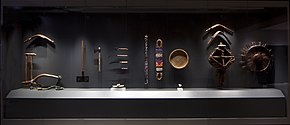
Bait Muzna Gallery is the first art gallery in Oman. Established in 2000 by Sayyida Susan Al Said, Bait Muzna has served as a platform for emerging Omani artists to showcase their talent and place themselves on the wider art scene. In 2016, Bait Muzna opened a second space in Salalah to branch out and support art film and the digital art scene. The gallery has been primarily active as an art consultancy.[270][272] The Omani Society for Fine Arts, established in 1993, offers educational programmes, workshops and artist grants for practitioners across varied disciplines.[270]
The Sultanate's flagship cultural institution, the National Museum of Oman, opened on 30 July 2016 with 14 permanent galleries. It showcases national heritage from the earliest human settlement in Oman two million years ago through to the present day. The museum takes a further step by presenting information on the material in Arabic Braille script for the visually impaired, the first museum to do this in the Gulf region.[270] Bait Al Zubair Museum is a private, family-funded museum that opened its doors to the public in 1998. In 1999, the museum received Sultan Qaboos' Award for Architectural Excellence. Bait Al Zubair displays the family's collection of Omani artifacts.[273]
Omani cuisine
[edit]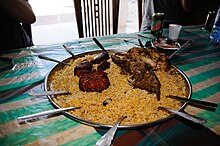
Omani cuisine is diverse and has been influenced by many cultures. Omanis usually eat their main daily meal at midday, while the evening meal is lighter. During Ramadan, dinner is typically served after the Taraweeh prayers, sometimes as late as 11 pm.
Арсия, праздничное блюдо, которое подают во время торжеств, состоит из рисового пюре и мяса (иногда курицы). Другое популярное праздничное блюдо, шува, состоит из мяса, которое очень медленно (иногда до двух дней) готовят в подземной глиняной печи. Рыбу также часто используют в основных блюдах, а королевская рыба – популярный ингредиент. Машуай — это блюдо, состоящее из целой королевской рыбы, зажаренной на вертеле, подаваемой с рисом с лимоном. Хлеб Рухал — это тонкий круглый хлеб, который едят во время любого приема пищи, обычно его подают с оманским медом на завтрак или посыпают карри на ужин. Оманская халва — очень популярная сладость, состоящая из приготовленного сахара-сырца с орехами. Существует много разных вкусов, наиболее популярными из которых являются черная халва (оригинальная) и шафрановая халва. Халва считается символом оманского гостеприимства и традиционно подается с кофе. Как и в большинстве арабских государств Персидского залива , алкоголь доступен без рецепта только немусульманам.
Спорт
[ редактировать ]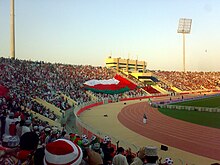
В октябре 2004 года правительство Омана учредило Министерство спорта, которое заменило Генеральную организацию по делам молодежи, спорта и культуры. 19- й Кубок Персидского залива проходил в Маскате с 4 по 17 января 2009 года и был выигран национальной сборной Омана по футболу . 23- й Кубок Персидского залива , который проходил в Кувейте с 22 декабря 2017 года по 5 января 2018 года, на котором Оман выиграл свой второй титул, победив Объединенные Арабские Эмираты в финале .
Традиционными видами спорта Омана являются скачки дау , скачки на лошадях , верблюжьи бега , бой быков и соколиная охота . [ 274 ] Ассоциация футбола, баскетбола , водных лыж и сэндбординга [ 275 ] относятся к числу видов спорта, которые быстро возникли и завоевали популярность среди молодого поколения. [ 274 ] Оман, наряду с Фуджейрой в ОАЭ которых организована разновидность корриды , известная как «бодание быков». , являются единственными регионами на Ближнем Востоке, на территории [ 276 ] Район Аль-Батена в Омане особенно известен такими мероприятиями.

Олимпийский комитет Омана сыграл важную роль в организации весьма успешных Олимпийских дней 2003 года, которые принесли большую пользу спортивным ассоциациям, клубам и молодым участникам. Футбольная , ассоциация приняла участие, а также ассоциации гандбола , баскетбола , регби , хоккея на траве , волейбола , легкой атлетики плавания и тенниса . В 2010 году Маскат принимал Азиатские пляжные игры 2010 года . Оман представил мужскую сборную по пляжному волейболу , которая участвовала в Континентальном кубке AVC по пляжному волейболу 2018–2020 годов . [ 277 ]
Оман также ежегодно проводит теннисные турниры. На стадионе спортивного комплекса Султана Кабуса есть 50-метровый бассейн, который используется для проведения международных турниров. Тур Омана, профессиональная 6-дневная многодневная многодневная гонка по велоспорту, проходит в феврале. Оман принимал отборочные матчи чемпионата мира по пляжному футболу в Азии 2011 года , где 11 команд боролись за три места на чемпионате мира по пляжному футболу . среди мужчин и женщин С 8 по 13 июля Оман принимал чемпионат мира по пляжному гандболу 2012 года на курорте «Миллениум» в Муссане. [ 278 ] Первое « Эль-Класико », сыгранное за пределами Испании, состоялось 14 марта 2014 года в спортивном комплексе Султана Кабуса . [ 279 ]
Оман неоднократно боролся за место на чемпионате мира по футболу , но еще не прошел квалификацию для участия в турнире. В крикете Оман квалифицировался на чемпионат мира ICC World Twenty20 2016 года и чемпионат мира по крикету T20 2021 года. примет в 2021 году . чемпионат мира ICC среди мужчин T20 25 июня 2021 года было подтверждено, что Оман вместе с Объединенными Арабскими Эмиратами [ 280 ]
Галерея
[ редактировать ]- Маскат, Оман
-
Мечеть в Маскате , Оман.
-
Форт Мутра, Маскат , Оман
-
Мечеть Аль-Амин, Маскат , Оман
-
Большая мечеть Султана Кабуса, Маскат , Оман
-
Корабль султана, Мутра, Маскат , Оман
-
Аль-Амарат Хиллз, Маскат , Оман
-
Пляж Аль-Азаиба, Маскат , Оман
-
Библиотека Большой мечети Султана Кабуса , Маскат , Оман
См. также
[ редактировать ]Примечания
[ редактировать ]- ↑ В 1783 году, когда Сейид Саид унаследовал «маснад» Маската и Омана (независимое государство, основанное в 1749 году), он поссорился со своим братом Имамом Султаном, который бежал в безопасное место в Макране и вступил в общение с Насир-ханом из Калата. . Саиду была предоставлена доля Калата в доходах Гвадара, и он жил там до 1797 года, когда он стал править Маскатом и Оманом.
- ↑ Гвадар оставался владением Омана в составе Султаната до сентября 1958 года.
- ^ Как для Омана, так и для иностранных граждан.
- ^ / oʊ ˈ m ɑː n / о- МАН ; Арабский : Оман , латинизированный : ʿUmān , произносится [ʕʊˈmaːn] .
- ^ Арабский: Султанат Оман , латинизированный: Salṭanat ʿUman .
Ссылки
[ редактировать ]- ^ «Основной статут государства, обнародованный Королевским указом 101/96» . МИНИСТЕРСТВО ЮСТИЦИИ И ПРАВОВЫХ ВОПРОСОВ . Архивировано из оригинала 7 июля 2020 года . Проверено 31 августа 2020 г.
- ^ «Национальные профили» .
- ^ Оман . MSN Энкарта. Архивировано из оригинала 28 октября 2009 года . Проверено 20 ноября 2008 г.
В 751 году мусульмане-ибади основали имамат в Омане. Несмотря на перерывы, имамат Ибади просуществовал до середины 20 века.
- ^ «Оман» . Фонд Карнеги за международный мир. 15 июля 2010 г. Проверено 31 декабря 2021 г.
- ^ Перейти обратно: а б «Перспективы мирового народонаселения 2022» . Департамент ООН по экономическим и социальным вопросам , Отдел народонаселения . Проверено 17 июля 2022 г.
- ^ Перейти обратно: а б «Перспективы мирового населения на 2022 год: Демографические показатели по регионам, субрегионам и странам ежегодно на 1950–2100 годы» (XSLX) («Общая численность населения по состоянию на 1 июля (тысяч)»). Департамент ООН по экономическим и социальным вопросам , Отдел народонаселения . Проверено 17 июля 2022 г.
- ^ «Окончательные итоги переписи населения 2010 года» (PDF) . Национальный центр статистики и информации. Архивировано из оригинала (PDF) 18 мая 2013 года . Проверено 7 января 2012 г.
- ^ Перейти обратно: а б с д «База данных «Перспективы развития мировой экономики», издание за октябрь 2023 г. (Оман)» . МВФ.org . Международный валютный фонд . 10 октября 2023 г. Проверено 13 октября 2023 г.
- ^ «Городской – индекс Джини – Оман – итого» . Национальный центр статистики и информации, Султанат Оман. Архивировано из оригинала 21 мая 2018 года . Проверено 20 мая 2018 г.
- ^ «Отчет о человеческом развитии 2023/24» (PDF) . Программа развития ООН . 13 марта 2024 г. Архивировано (PDF) из оригинала 13 марта 2024 г. . Проверено 13 марта 2024 г.
- ^ «Население Омана (2024 г.)» . Мирометр. Архивировано из оригинала 10 июня 2020 года . Проверено 15 января 2024 г.
- ^ Перейти обратно: а б Харуси, Н.С. (2012). «Этнический ярлык зинджибари: политика и последствия выбора языка среди носителей суахили в Омане». Этносы . 12 (3): 335–353. дои : 10.1177/1468796811432681 . ISSN 1468-7968 . S2CID 145808915 .
- ^ Перейти обратно: а б с д и ж г час я дж к «Страновой отчет: Оман» . Проект БТИ. 2016. Архивировано из оригинала 12 марта 2020 года . Проверено 19 августа 2016 г.
- ^ «Хайтам бин Тарик принес присягу в качестве нового султана Омана» . Аль Джазира. 12 января 2020 года. Архивировано из оригинала 11 января 2020 года . Проверено 12 января 2020 г.
- ^ Перейти обратно: а б с «Профиль Омана – Обзор» . Новости Би-би-си. 11 сентября 2012 г. Архивировано из оригинала 12 марта 2020 г. Проверено 18 января 2013 г.
- ^ Музей Королевских ВВС , История Омана . Проверено 19 ноября 2020 г.
- ^ «Частный сектор получает цели оманизации» . Новости Персидского залива . 13 февраля 2011 года. Архивировано из оригинала 9 октября 2019 года . Проверено 18 января 2013 г.
- ^ «Пять арабских государств среди лидеров долгосрочного развития» . Hdr.undp.org. 4 ноября 2010 года. Архивировано из оригинала 9 ноября 2013 года . Проверено 29 октября 2011 г.
- ^ «Глобальный индекс мира: 2021» (PDF) . www.visionofhumanity.org . Глобальный индекс миролюбия и Институт экономики и мира . п. 9. Архивировано (PDF) из оригинала 24 марта 2022 года . Проверено 6 апреля 2022 г.
- ^ «Доисламский – САА» . saa.shj.ae . Архивировано из оригинала 8 октября 2023 года . Проверено 6 октября 2023 г.
- ^ Плиний Старший . Естественная история , VI.149.
- ^ Птолемей, Клавдий . География . VI.7.36.
- ^ Перейти обратно: а б Брилл, Э.Дж. (1987) [1913]. Первая энциклопедия ислама Э. Дж. Брилла 1913-1936 гг . Лейден: БРИЛЛ. ISBN 978-90-04-08265-6 .
- ^ История Умани [ Оман в истории ].
- ^ Роуз, Дж.И.; Усик, В.И.; Маркс, А.Э.; Гильберт, Ю.Х.; Галлетти, CS; Партон, А.; Гейлинг, Дж. М.; Черный, В.; Морли, Миссури; Робертс, Р.Г. (2011). «Нубийский комплекс Дофара, Оман: африканская промышленность среднего каменного века в Южной Аравии» . ПЛОС ОДИН . 6 (11): e28239. Бибкод : 2011PLoSO...628239R . дои : 10.1371/journal.pone.0028239 . ПМК 3227647 . ПМИД 22140561 .
- ^ Джеффри И. Роуз и др., Южный Пенджаб, Оман: африканская промышленность среднего каменного века в Южной Аравии, Плос, 30 ноября 2011 г. дои : 10.1371/journal.pone.0028239
- ^ Торнтон, Кристофер; Кейбл, Шарлотта; Поссель, Грегори (2016). Башни бронзового века в Бате, Султанат Оман… 2007–2012 гг . Музей Пенсильванского университета. ISBN 9781934536063 .
- ^ Перейти обратно: а б Британский национальный архив: Салил-ибн-Разик «История имамов и сейидов Омана». Архивировано 7 июля 2022 года в Wayback Machine. История имамов и сейидов Омана. Британский национальный архив, стр. 39 QDL
- ^ Перейти обратно: а б с д и Салил-ибн-Разик. Британский национальный архив: История имамов и сейидов Омана (54/612) . Архивировано 8 июля 2022 года в Wayback Machine. История имамов и сейидов Омана. Британский национальный архив. Страница 54. QDL.
- ^ Уилкинсон, Джон (1977). Вода и племенные поселения в Юго-Восточной Аравии – исследование афладжа в Омане . Кларендон Пресс. стр. 76, 85, 122, 126–130, 132. ISBN. 0198232179 .
- ^ Юл, Пол (2014). Перекресток дорог раннего и позднего железного века, Юго-Восточная Аравия . Харрасовиц Верлаг. стр. 15–18. ISBN 9783447101271 .
- ^ «Раскопки в земле Маган - Архив журнала «Археология»» . Archive.archaeology.org. Архивировано из оригинала 23 октября 2013 года . Проверено 14 января 2014 г.
- ^ «Оман: Затерянная земля» . Саудовская Арамко Мир . Март 1983 года. Архивировано из оригинала 6 октября 2014 года . Проверено 14 января 2014 г.
- ^ «Оман: История» . Саудовская Арамко Мир . Март 1983 года. Архивировано из оригинала 28 декабря 2014 года . Проверено 14 января 2014 г.
- ^ Фейерштейн, Джордж; Как, Субхаш; Фроули, Дэвид (2005). В поисках колыбели цивилизации: новый взгляд на Древнюю Индию . Издательство Мотилал Банарсидасс. п. 119. ИСБН 8120820371 .
- ^ Герд Вайсгербер «Больше, чем медь в Омане», раздел 5-6, 1981, 180–181 Археология Омана
- ^ Перейти обратно: а б с Салил-ибн-Разик. Британский национальный архив: История имамов и сейидов Омана (40/612). Архивировано 7 июля 2022 года в Wayback Machine. История имамов и сейидов Омана. Британский национальный архив. КДЛ.
- ^ Анналы Омана. Британский национальный архив: Анналы Омана [3] (20/112). Архивировано 8 марта 2021 года в Британском национальном архиве Wayback Machine . Страница 20. QDL.
- ^ Перейти обратно: а б Ульрих, Брайан (2008). «Переосмысление миграции Азд: рассказы Амра Музайкии и Малика бен Фама в историографическом контексте Брайана Ульриха (21 июля 2007 г.)». Материалы семинара по арабистике . 38 . JSTOR: 311–318. JSTOR 41223958 .
- ^ Майзель и Шуп 2009 , с. 193.
- ^ Роберт Геран Ланден (8 декабря 2015 г.). Оман С 1856 (1967) . Библиотека наследия Принстона. ISBN 9781400878277 . Архивировано из оригинала 11 февраля 2023 года . Проверено 8 мая 2020 г.
- ^ Хопвуд, Дерек (2016). Аравийский полуостров: общество и политика . Рутледж.
- ^ Хоули, Дональд (1984). Оман и его возрождение . Гуманитарная пресса. п. 18.
- ^ «История ОМАН» . Historyworld.net. Архивировано из оригинала 2 августа 2009 года . Проверено 17 апреля 2010 г.
- ^ «Оман» . Государственный департамент США . 31 марта 2010 г. Архивировано из оригинала 17 августа 2021 г. Проверено 9 июля 2010 г.
Оман принял ислам в седьмом веке нашей эры, при жизни Мухаммеда.
- ^ Салил-ибн-Разик. Британский национальный архив: История имамов и сейидов Омана (44/612). Архивировано 7 июля 2022 года в Wayback Machine. История имамов и сейидов Омана. Британский национальный архив. Страница 44. QDL.
- ^ Перейти обратно: а б с д и ж г Маджид Алхалили. Маджид Алхалили: внешняя политика Омана . Архивировано 13 апреля 2023 года в Wayback Machine: Внешняя политика Омана: основы и практика. 19 мая 2009 г. Прегер.
- ^ Салил-ибн-Разик. Британский национальный архив: История имамов и сейидов Омана (164/612). Архивировано 7 июля 2022 года в Wayback Machine. История имамов и сейидов Омана. Британский национальный архив. Страница 164. QDL.
- ^ Салил-ибн-Разик. Британский национальный архив: История имамов и сейидов Омана (165/612). Архивировано 8 марта 2021 года в Wayback Machine. История имамов и сейидов Омана. Британский национальный архив. Страница 165. QDL.
- ^ Салил-ибн-Разик. Британский национальный архив: История имамов и сейидов Омана (166/612). Архивировано 7 июля 2022 года в Wayback Machine. История имамов и сейидов Омана. Британский национальный архив. Страница 166. QDL.
- ^ Ганс Крузе. Записки и меморандумы Омана Ганса Крузе . Архивировано 10 июля 2022 года в журнале Wayback Machine Disturbances в Омане: заметки и меморандумы Омана. Журналы мудрецов. 1 октября 1965 года.
- ^ Перейти обратно: а б Салил-ибн-Разик. Британский национальный архив: История имамов и сейидов Омана (46/612). Архивировано 9 июля 2022 года в Wayback Machine. История имамов и сейидов Омана. Британский национальный архив. Страница 46. QDL.
- ^ Салил-ибн-Разик. Британский национальный архив: История имамов и сейидов Омана, автор Салил-ибн-Разик, 661–1856 гг. Н.э. (168/612). Архивировано 7 июля 2022 года в Wayback Machine. История имамов и сейидов Омана. Британский национальный архив. Страница 168. QDL.
- ^ Перейти обратно: а б с д и Джей Си Уилкинсон. Оманский вопрос: предпосылки политической географии Юго-Восточной Аравии. Архивировано 16 июня 2022 года в Wayback Machine. Оманский вопрос: предыстория политической географии Юго-Восточной Аравии. Страницы 361–371. Географический журнал. ДЖСТОР. 1971.
- ^ Перейти обратно: а б Узи Раби. Возникновение государств в племенном обществе: Оман при Саиде бин Таймуре. Возникновение государств в племенном обществе: Оман при Саиде бин Таймуре.
- ^ Раввин Уззи (11 марта 2011 г.). Возникновение государств в племенном обществе: Оман при Саиде бин Тимуре, 1932–1970 гг . Книги Аполлона. ISBN 9781845194734 – через Google Книги.
- ^ Набхан, Гэри Пол (11 марта 2008 г.). Арабско-американский: ландшафт, культура и кухня в двух великих пустынях . Издательство Университета Аризоны. ISBN 9780816526581 – через Google Книги.
- ^ Салил-ибн-Разик. Британский национальный архив: История имамов и сейидов Омана (202/612) . Архивировано 8 марта 2021 года в Wayback Machine. История имамов и сейидов Омана. Британский национальный архив. Страница 202. QDL.
- ^ Гэвин Томас. Путеводитель по Оману. Архивировано 11 февраля 2023 года в Wayback Machine The Rough Guide to Oman.
- ^ Холт, Питер Малкольм; Лэмбтон, Энн К.С. и Льюис, Бернард (1977) Кембриджская история ислама Издательство Кембриджского университета ISBN 0521291364 .
- ^ Уиллем Флор, «Отношения Голландии с Персидским заливом», в книге Лоуренса Г. Поттера (редактор), « Персидский залив в истории» (Palgrave Macmillan, 2009), с. 240
- ^ Перейти обратно: а б Профиль страны Омана. Профиль страны Омана. Архивировано 20 июля 2019 года в Партнерстве британских библиотек Wayback Machine . Цифровая библиотека Катара. 2014.
- ^ « История имамов и сейидов Омана, написанная Салилом ибн-Разиком, 661–1856 гг. н.э.; переведена с оригинального арабского языка и отредактирована с примечаниями, приложениями и введением, продолжающим историю до 1870 года, написанная Джорджем Перси Бэджер, ФРГС, покойный капеллан в президентстве Бомбея. [23] (56/612)» . Цифровая библиотека Катара . 22 октября 2014 г. Архивировано из оригинала 7 июля 2022 г. Проверено 6 сентября 2019 г.
- ^ Стефан Зиберт. Грубый путеводитель по Оману. Архивировано 11 февраля 2023 года в Wayback Machine The Rough Guide to Oman. 2011.
- ^ Салил-ибн-Разик. История имамов и сейидов Омана, составленная Салил-ибн-Разиком, 661–1856 гг. Н.э. (83/612), Британский национальный архив . Архивировано 10 марта 2021 года в Wayback Machine. История имамов и сейидов Омана. Британский национальный архив. Страница 83. QDL.
- ^ Салил-ибн-Разик. История имамов и сейидов Омана, написанная Салил-ибн-Разиком, 661–1856 гг. Н.э. (86/612). Архивировано 7 июля 2022 года в Wayback Machine. История имамов и сейидов Омана. Британский национальный архив. Страница 86. QDL.
- ^ Салил-ибн-Разик. История имамов и сейидов Омана, составленная Салил-ибн-Разиком, 661–1856 гг. Н.э. (92/612), Британский национальный архив . Архивировано 7 июля 2022 года в Wayback Machine. История имамов и сейидов Омана. Британский национальный архив. Страница 92. QDL.
- ^ Перейти обратно: а б Роберт Геран Ланден. Оман с 1856 года: разрушительная модернизация в традиционном арабском обществе. Архивировано 10 июля 2022 года в Wayback Machine, Оман. С 1856 года: разрушительная модернизация в традиционном арабском обществе. Журнал Американского восточного общества. Страницы 581–583. ДЖСТОР. 1970. Том. 90, № 4.
- ^ Ковасджи, Ардешир (11 сентября 2005 г.). «Рассвет – Уголок Ковасджи; 11 сентября 2005 г.» . Группа газет РАССВЕТ. Архивировано из оригинала 9 июня 2010 года . Проверено 27 июля 2010 г.
- ^ Перейти обратно: а б с д Д-р Фрэнсис Оутрам (11 декабря 2014 г.). «Близкие отношения: Великобритания и Оман с 1750 года» . КДЛ. Архивировано из оригинала 8 марта 2021 года . Проверено 27 июля 2019 г. 2014.
- ^ [Джозеф А. Кечичян «Оман и мир: появление независимой внешней политики» RAND 1995]
- ^ Перейти обратно: а б Салил-ибн-Разик. История имамов и сейидов Омана, автор Салил-ибн-Разик, 661–1856 гг. Н.э. (89/612). Архивировано 8 марта 2021 года в Wayback Machine. История имамов и сейидов Омана. Британский национальный архив. Страница 89. QDL.
- ^ Маскат и муссон. Британский национальный архив: Маскат и сезон дождей. Архивировано 8 марта 2021 года в Британском национальном архиве Wayback Machine . КДЛ.
- ^ Сборник договоров и обязательств. Британские национальные архивы: Сборник договоров и обязательств, касающихся шейхов Персидского залива и Султаната Маскат и Оман, действовавших до конца 1953 года» [26v] (54/92) . Архивировано 6 июля 2022 года в Британском национальном архиве Wayback Machine . Страница 54. QDL.
- ^ Историческое изложение событий. Британский национальный архив: историческое изложение событий 189/222. Архивировано 8 марта 2021 года в Британском национальном архиве Wayback Machine . Страница 189. QDL.
- ^ История внутренних дел Маската и Омана. Британский национальный архив: история внутренних дел Маската и Омана. Архивировано 8 марта 2021 года в Британском национальном архиве Wayback Machine . Страница 191. QDL.
- ^ Перейти обратно: а б с д и Ян Кобейн. The Guardian: Секретные войны Великобритании. Архивировано 30 сентября 2016 года в Wayback Machine. Секретные войны Британии. Хранитель . 8 сентября 2016 г.
- ^ Финансовые проблемы Саида бин Таймура. Британский национальный архив: Финансовые проблемы Саида бин Таймура. Архивировано 11 ноября 2020 года в Британском национальном архиве Wayback Machine . КДЛ.
- ^ Перейти обратно: а б 2302 Вопрос Омана. Организация Объединенных Наций: 2302 Вопрос Омана . Архивировано 26 октября 2021 года в Wayback Machine United Nations. 12 декабря 1967 года.
- ↑ ЕЦБ МакЛорин «Оман и побережье мира». Архивировано 17 января 2023 года в Wayback Machine Oman and the Trucial Coast. Страницы 65–76. Австралийский ежеквартальный журнал. ДЖСТОР. 1958.
- ^ Государственные дела Маската. Британский национальный архив: файл 8/67 Государственные дела Маската: Договор между Маскатом и Оманом. Архивировано 8 июля 2022 года в Британском национальном архиве Wayback Machine . Файл 8/67. Страница 20. QDL.
- ^ Перейти обратно: а б с «Джебель Ахдар» . Маленькие войны Британии. Архивировано из оригинала 17 сентября 2013 года . Проверено 10 апреля 2012 г.
- ^ Восстание Маската. Британский национальный архив: Восстание Маската, с апреля 1917 года по январь 1918 года и возобновление с апреля 1920 года по октябрь 1920 года. Архивировано 7 июля 2022 года в Wayback Machine Британский национальный архив QDL.
- ^ Перейти обратно: а б Профиль Омана – Хронология. «BBC Ближний Восток: профиль Омана – хронология (25 апреля 2018 г.)» . Новости Би-би-си. 25 апреля 2018 г. Архивировано из оригинала 11 июня 2022 г. . Проверено 2 августа 2019 г. 25 апреля 2018 г.
- ^ Обязательство султана Таймура относительно нефти. Обязательства султана Таймура относительно нефти . Архивировано 9 марта 2021 года в Wayback Machine Британского национального архива, стр. 60 QDL.
- ^ Соглашение о красной линии 1928 года. Управление историка США: Соглашение о красной линии 1928 года. Архивировано 17 июля 2019 года в Wayback Machine . офисе историка США
- ^ Восстание Маската. Британский национальный архив: Восстание Маската, с апреля 1917 года по январь 1918 года и возобновление с апреля 1920 года по октябрь 1920 года. Архивировано 25 февраля 2021 года в Wayback Machine. Британский национальный архив, страница 190 QDL.
- ^ Перейти обратно: а б с Марк Кертис. Британский национальный архив. Архивировано 3 марта 2021 года в Wayback Machine Oman 1957-9. Британский национальный архив. 2017.
- ^ Фред Холлидей. Аравия, автор Фред Холлидей. Архивировано 6 апреля 2023 года в Wayback Machine Arabia. Аравийский полуостров. Книги Саки. Калифорнийский университет. опубликовано в 1974 году.
- ^ Перейти обратно: а б Петерсон, Дж. Э. (2 января 2013 г.). Повстанцы Омана: борьба султаната за господство . Саки. ISBN 9780863567025 . Архивировано из оригинала 11 февраля 2023 года . Проверено 29 апреля 2018 г. - через Google Книги.
- ^ Историческое изложение событий в Персидском заливе. «Британский национальный архив: Историческое изложение событий в Персидском заливе (208/222)» . КДЛ. 30 мая 2014 г. Архивировано из оригинала 23 июля 2019 г. Британский национальный архив. Страница 208.
- ^ «Оман» . NevingtonWarMuseum.com . Проверено 9 августа 2024 г.
- ^ «Вторая мировая война» . Музей Королевских ВВС . Проверено 9 августа 2024 г.
- ^ «Немецкая подводная лодка времен Второй мировой войны находится у берегов Омана» . Рентгеновский журнал . 16 сентября 2011 года . Проверено 9 августа 2024 г.
- ^ Болдуин, Дерек (17 декабря 2009 г.). «Что скрывается под: крушение нацистов у Фуджейры» . Новости Персидского залива . Проверено 9 августа 2024 г.
- ^ Николин, Беатрис (25 мая 1998 г.). «Международные торговые сети: Оманский анклав Гвадар - Конференция по немецким и международным исследованиям Омана, Бонн, 1998: тезисы» . Бонн: Конференция по немецким и международным исследованиям Омана. Архивировано из оригинала 4 января 2020 года . Проверено 27 июля 2010 г.
- ^ Государственные дела Маската. ACGallowey: Файл 8/62 Государственные дела Маската: Главные шейхи и племена Омана [35r] (69/296) . Архивировано 8 марта 2021 года в Wayback Machine Principal Shaikhs and Tribes of Oman. Британский национальный архив. Страница 69. QDL.
- ^ Государственные дела Маската. Британское консульство в Маскате: Файл 8/62 Государственные дела Маската: главные шейхи и племена Омана. Архивировано 8 марта 2021 года в Британском национальном архиве Wayback Machine . Файл 8/62. Страница 153. 25 мая 1946 г. QDL.
- ^ Государственные дела Маската. Министерство иностранных дел Лондона: Файл 8/62 Государственные дела Маската: Главные шейхи и племена Омана [146r] (291/296). Архивировано 8 марта 2021 года в Британском национальном архиве Wayback Machine . Страница 291. QDL.
- ^ Петерсон, Джон Э. (1978). Оман в двадцатом веке: политические основы развивающегося государства . Крумский шлем. п. 182. ИСБН 9780856646294 .
- ^ Жидкий Оман: нефть, вода и причинно-следственная связь в Южной Аравии. Жидкий Оман: нефть, вода и причинно-следственные связи в Южной Аравии. Архивировано 17 января 2023 года в Королевском антропологическом институте Wayback Machine . С. 147–162. 2016. Городской университет Нью-Йорка.
- ^ Перейти обратно: а б Райан, Майк (2003). Секретные операции САС . Зенит Отпечаток. стр. 68–70. ISBN 9780760314142 . [ постоянная мертвая ссылка ]
- ^ Перейти обратно: а б с Оутрам, Фрэнсис (2004). Современная история Омана: формирование государства с 1920 года . ИБТаурис. п. 106. ИСБН 9781860646171 .
- ^ Последний имам Омана. CNN на арабском языке: последний имам Омана умирает в политической ссылке в Саудовской Аравии. Архивировано 11 апреля 2022 года в Wayback Machine CNN Arab News. 1 декабря 2009 года. Маскат, Оман.
- ^ 10 арабских государств задают вопрос дебатам ООН по Оману. Нью-Йорк Таймс. 1 октября 1960 года. Архивировано 17 января 2023 года в Wayback Machine The New York Times .
- ^ Вопрос Омана. Архивы Организации Объединенных Наций. Архивировано 18 августа 2021 года в Wayback Machine . Архиве ООН
- ^ Резолюции, принятые 20-й сессией. Организация Объединенных Наций: 20-я сессия приняла резолюции . Архивировано 17 мая 2022 года в Wayback Machine United Nations. 20 сентября – 20 декабря 1965 г.
- ^ 2073 Вопрос Омана. Организация Объединенных Наций: 2073 Вопрос Омана . Архивировано 8 марта 2021 года в Wayback Machine United Nations. 17 декабря 1965 года.
- ^ Резолюции, принятые 22-й сессией. Организация Объединенных Наций: 22-я сессия приняла резолюции . Архивировано 17 мая 2022 года в Wayback Machine United Nations. 19 сентября – 19 декабря 1967 г.
- ^ Генеральная Ассамблея ООН. «Резолюция ООН 2238 по вопросу Омана (1966 г.)» (PDF) . мирлии. Архивировано (PDF) из оригинала 7 марта 2021 года . Проверено 27 августа 2019 г.
- ^ Генеральная Ассамблея ООН. «Резолюции, принятые ООН (1966 г.)» . мирлии. Архивировано из оригинала 25 апреля 2022 года . Проверено 27 августа 2019 г.
- ^ «Счастлив и богат в игрушечном городке Омана» . Экономист . 31 августа 2000 г. Архивировано из оригинала 21 ноября 2018 г.
- ^ Аль-Фалих, Абдулазиз бин Абдулла (2021). Я был студентом в Аммане (на арабском языке). Дом Тулутии. ISBN 9786030362981 .
- ^ «Спустя 38 лет... студенты из Султаната Оман навещают своего учителя в Саудовской Аравии » . www.al-jazirah.com . Архивировано из оригинала 3 января 2024 года . Проверено 16 сентября 2023 г.
- ^ Бенджамин Плакетт (30 марта 2017 г.). «Оманская музыка маскирует прошлое работорговли» . Аль-Фанар Медиа. Архивировано из оригинала 17 января 2023 года . Проверено 17 июля 2017 г.
- ^ «Оман назначает первую женщину-министра» . Новости Би-би-си . 4 марта 2003 г. Архивировано из оригинала 17 сентября 2019 г.
- ^ «Профиль Омана – Хронология» . Новости Би-би-си . 11 сентября 2012 г. Архивировано из оригинала 10 мая 2019 г. . Проверено 18 января 2013 г.
- ^ «Султан Омана Кабус умер в возрасте 79 лет» . Новости Би-би-си . 11 января 2020 года. Архивировано из оригинала 5 апреля 2020 года . Проверено 10 января 2020 г. .
- ^ «Хайтам бин Тарик назначен новым правителем Омана» . Арабские новости . 11 января 2020 г. Архивировано из оригинала 13 января 2020 г.
- ^ «География Омана 2007» . home.kpn.nl. Архивировано из оригинала 25 сентября 2018 года . Проверено 11 июля 2016 г.
- ^ «Отчет об экспедиции: Горы Дофар, Оман» . 30 апреля 2011 года. Архивировано из оригинала 10 октября 2017 года . Проверено 11 июля 2016 г.
- ^ Перейти обратно: а б Крог, Ян С. «Оман» . jankrogh.com. Архивировано из оригинала 4 мая 2019 года.
- ^ «Нахва – Объединенные Арабские Эмираты» . geosite.jankrogh.com . Архивировано из оригинала 9 мая 2019 года.
- ^ 4-е Швейцарское совещание геонаук, Берн, 2006. Поверхности скопления метеоритов в Омане: основные результаты. Оманско-швейцарские кампании по поиску метеоритов, 2001–2006 гг. Беда Хофманн и др.
- ^ «Маскат (Сиб) Климат Омана» . www.world-climate.com. Архивировано из оригинала 7 апреля 2014 года . Проверено 11 июля 2016 г.
- ^ «Оман — Профили пастбищных/кормовых ресурсов страны» . Продовольственная и сельскохозяйственная организация. Архивировано из оригинала 25 июня 2016 года . Проверено 28 января 2013 г.
- ^ «Климат Салалы - Климат Салалы, Оман» . world-climate.com. Архивировано из оригинала 9 августа 2017 года . Проверено 11 июля 2016 г.
- ^ «Погода — Оман» . Би-би-си. Архивировано из оригинала 24 января 2013 года . Проверено 21 января 2013 г.
- ↑ Снег покрывает горы Омана из-за падения температуры. Архивировано 13 апреля 2014 года в Wayback Machine . Gulf News (16 февраля 2014 г.). Проверено 20 апреля 2014 г.
- ^ Энциклопедия Филиппа . Филиппа. 2008.
- ^ «Курият в Омане бьет мировой рекорд температуры» . Си-Эн-Эн. 2018. Архивировано из оригинала 3 июля 2018 года . Проверено 29 июля 2018 г.
- ^ Перейти обратно: а б с Информационные панели Отчета об устойчивом развитии 2019 Оман. Омана Информационные панели Отчета об устойчивом развитии за 2019 год . Индекс ЦУР . 2019.
- ^ «Зона данных BirdLife» . datazone.birdlife.org. Архивировано из оригинала 9 октября 2022 года . Проверено 11 августа 2021 г.
- ^ «Центр всемирного наследия ЮНЕСКО – заповедник арабского орикса в Омане: первый объект, когда-либо исключенный из Списка всемирного наследия ЮНЕСКО» . ЮНЕСКО. Архивировано из оригинала 5 июля 2020 года . Проверено 17 апреля 2010 г.
- ↑ Трагедия с животными. Архивировано 29 мая 2016 года в Wayback Machine . y-oman.com. 27 июня 2013 г.
- ↑ Макдональд, Сара (22 марта 2014 г.). Бродячие по улицам - растущая проблема для Омана. Архивировано 12 января 2015 г. в Wayback Machine . Времена Омана
- ^ Пленные существа. Архивировано 30 июня 2016 года в Wayback Machine . y-oman.com. 21 ноября 2013 г.
- ^ Эттингер, Пауэлл. «Киты и дельфины Омана – дельфины, горбатые и синие киты!» . Архивировано из оригинала 29 июля 2016 года . Проверено 21 января 2016 г.
- ^ «Вопросы и ответы: Выборы в Консультативный совет Омана» . Новости Би-би-си . Архивировано из оригинала 28 января 2020 года . Проверено 21 июля 2018 г.
- ^ «Оман» . Дом Свободы . Архивировано из оригинала 23 апреля 2019 года . Проверено 18 января 2013 г.
- ^ «ОМАН Маджлес А'Шура (Консультативный совет)» . Межпарламентский союз. Архивировано из оригинала 27 февраля 2013 года . Проверено 19 января 2013 г.
- ^ «Оман» . Свобода в мире 2012 . Дом Свободы. 17 января 2012 года. Архивировано из оригинала 25 октября 2012 года . Проверено 28 января 2013 г.
- ^ Перейти обратно: а б «Тоже просыпаюсь» . Экономист . 23 июня 2012 года. Архивировано из оригинала 28 декабря 2017 года . Проверено 19 января 2013 г.
- ^ Сторк, Джо (19 декабря 2012 г.). «Права человека в небольших государствах Персидского залива: Бахрейн, Кувейт, Оман, Катар и ОАЭ» . НОРЭФ . Архивировано из оригинала 8 марта 2014 года . Проверено 18 января 2013 г.
- ^ «Основной статут государства» (PDF) . Королевский указ 101/96 . Министерство юстиции . Архивировано из оригинала (PDF) 23 июля 2013 года . Проверено 18 августа 2012 г.
- ^ «Поправка к некоторым положениям Основного статута государства» (PDF) . Королевский указ 99/2011 . Министерство юстиции. Архивировано из оригинала (PDF) 17 января 2013 года.
- ^ Перейти обратно: а б «Профили стран (законодательные органы) – Оман» . Арабские парламенты. Архивировано из оригинала 5 июня 2012 года.
- ^ Перейти обратно: а б «Законодательная власть» . Всемирная книга фактов . Архивировано из оригинала 13 июня 2007 года . Проверено 19 января 2013 г.
- ^ Перейти обратно: а б с д и «Оман» . ЦРУ – Всемирная книга фактов. Архивировано из оригинала 13 марта 2021 года . Проверено 29 октября 2011 г.
- ^ Кечичян, Джозеф А. (1995). «Оман: уникальная внешняя политика» . РЭНД. Архивировано из оригинала 4 марта 2016 года . Проверено 29 октября 2011 г.
- ^ Рой, Шубхаджит (13 февраля 2018 г.). «Индия получает доступ к стратегическому оманскому порту Дукм для использования в военных целях, в пределах видимости Чабахар-Гвадар» . Индийский экспресс . Архивировано из оригинала 10 апреля 2019 года . Проверено 24 марта 2019 г.
- ^ По данным SIPRI. Архивировано 2 мая 2019 г. в Wayback Machine | Таблица Excel. Архивировано 24 февраля 2022 г. в Wayback Machine.
- ^ Военные расходы Омана. Военные расходы Омана, Всемирный банк. Архивировано 18 января 2023 года в Wayback Machine , Всемирный банк. Получено в 2019 году.
- ^ Перейти обратно: а б с д Энтони Х. Кордесман; Халид Р. Аль-Родхан (28 июня 2006 г.). «Военные силы Персидского залива в эпоху асимметричной войны» (PDF) . Центр стратегических и международных исследований. Архивировано из оригинала (PDF) 17 мая 2013 года . Проверено 19 января 2013 г.
- ^ «Время испытаний корвета» . Морская фотография. 15 марта 2012 года. Архивировано из оригинала 13 октября 2014 года . Проверено 21 января 2013 г.
- ^ «База данных военных расходов SIPRI» . Стокгольмский международный институт исследования проблем мира. Архивировано из оригинала 28 марта 2010 года . Проверено 29 октября 2011 г.
- ^ «Балансирование» . Экономист . 15 сентября 2009 года. Архивировано из оригинала 28 декабря 2014 года . Проверено 19 января 2013 г.
- ^ «ТОП-ЛИСТ TIV ТАБЛИЦ» . СИПРИ . Архивировано из оригинала 14 февраля 2013 года . Проверено 22 июня 2017 г.
- ^ «Пытки в Омане» . Центр Персидского залива по правам человека. 2014. Архивировано из оригинала 7 сентября 2019 года . Проверено 29 декабря 2014 г.
- ^ «Пытки в Омане» . Центр Персидского залива по правам человека. 2014. Архивировано из оригинала 24 июля 2019 года . Проверено 29 декабря 2014 г.
Практика пыток широко распространена в государственных пенитенциарных учреждениях Омана и стала реакцией государства на независимое политическое выражение, говорится в опубликованном сегодня докладе Центра по правам человека Персидского залива (GCHR).
- ^ Перейти обратно: а б «BTI 2014 – Страновой отчет Омана» . Проект БТИ. 2014. Архивировано из оригинала 28 декабря 2014 года . Проверено 29 декабря 2014 г.
- ^ Перейти обратно: а б «Отчеты о правах человека за 2013 год: Оман» . Государственный департамент США . 2014. Архивировано из оригинала 19 августа 2019 года . Проверено 29 декабря 2014 г.
- ^ «Гомофобия, спонсируемая государством. Мировой обзор законов, запрещающих однополые отношения между взрослыми по обоюдному согласию» (PDF) . Архивировано из оригинала (PDF) 20 октября 2016 года . Проверено 31 декабря 2014 г.
- ^ Перейти обратно: а б Оман: События 2018 года . Хьюман Райтс Вотч. 17 декабря 2018 года. Архивировано из оригинала 18 января 2023 года . Проверено 17 апреля 2019 г.
- ^ Перейти обратно: а б с д и ж г час я дж к л м Уитакер, Брайан (2011). «Султан Омана Кабус: классный деспот» . Хранитель . Архивировано из оригинала 18 января 2023 года . Проверено 29 декабря 2014 г.
- ^ «Страновой отчет: Оман» (PDF) . Проект БТИ. 2016. с. 12. Архивировано из оригинала (PDF) 8 августа 2019 года . Проверено 3 июня 2016 г.
- ^ «Оман: журналисты осуждены за статьи, в которых утверждается о коррупции» . Хьюман Райтс Вотч. 3 октября 2016 г. Архивировано из оригинала 18 января 2023 г. . Проверено 2 марта 2017 г.
- ^ Баррингтон, Лиза (19 апреля 2023 г.). «Оман либерализует иностранное законодательство о браке, проводя редкую социальную реформу» . Рейтер . п. 1. Архивировано из оригинала 4 декабря 2023 года . Проверено 16 мая 2024 г.
- ^ Сьюзан Аль Шахри (2012). «Табуированная тема: отчаянное положение домашних работников в Омане» . Ближневосточные посты. Архивировано из оригинала 28 декабря 2014 года . Проверено 29 декабря 2014 г.
- ^ Перейти обратно: а б Сьюзан Мубарак (2012). «То, о чем мы не говорим» . Маскат Дейли . Архивировано из оригинала 28 декабря 2014 года . Проверено 29 декабря 2014 г.
- ^ «Безопасна ли какая-либо страна на Ближнем Востоке для рабочих-мигрантов?» . migrrights.org. 2011. Архивировано из оригинала 30 декабря 2014 года . Проверено 29 декабря 2014 г.
- ^ «Архивы Омана» . Международная амнистия. Архивировано из оригинала 15 апреля 2022 года . Проверено 15 апреля 2022 г.
- ^ «Об Омане» . Национальный центр статистики и информации. Архивировано из оригинала 31 июля 2013 года . Проверено 13 февраля 2013 г.
- ^ «Провинции Султаната Оман» . Министерство информации Султаната Оман. Архивировано из оригинала 8 декабря 2013 года.
- ^ Перейти обратно: а б «Основной статут государства» (PDF) . Министерство Юридических Дел. Архивировано из оригинала (PDF) 26 июня 2012 года.
- ^ «10 крупнейших экспортных товаров Омана» . Крупнейший экспортный товар в мире . 10 июля 2019 года. Архивировано из оригинала 6 октября 2022 года . Проверено 29 сентября 2019 г.
- ^ Перейти обратно: а б с д Страновой отчет Омана. Страновой отчет Омана за 2018 год. Архивировано 12 марта 2020 года в индексе трансформации Wayback Machine Transformation Index BTI. 2018.
- ^ Перейти обратно: а б с Неуловимая занятость: планирование развития и тенденции на рынке труда в Омане. Планирование развития и тенденции на рынке труда в Омане, 2014 г. Архивировано 7 октября 2022 г. в Wayback Machine Researchgate. Сентябрь 2014.
- ^ Новости химии и машиностроения , 5 января 2009 г., «Пакт США и Омана расширяет свободную торговлю», стр. 18
- ^ Перейти обратно: а б с Харуси, Н.С.; Салман, А. (сентябрь 2011 г.). «Английская транслитерация географических названий в Омане» . Журнал академических и прикладных исследований . 1 (3): 1–27.
- ^ Перейти обратно: а б с Оман – Обзор рынка. Оман – Обзор рынка (US Export.gov), 2018 г. Архивировано 13 сентября 2019 г. на сайте Wayback Machine Export.gov. 2018.
- ^ Перейти обратно: а б «Индийские рабочие-мигранты в Омане беседуют с МСВС» . Wsws.org. 28 октября 2005 г. Архивировано из оригинала 28 октября 2012 г. Проверено 29 октября 2011 г.
- ^ «Энтони встречается с индийской диаспорой в Омане» . Тайндиан.com. 18 мая 2010 года. Архивировано из оригинала 12 июня 2016 года . Проверено 29 октября 2011 г.
- ^ Перейти обратно: а б Бюджет Омана на 2019 год. KPMG Insights. КПМГ: Бюджет Омана на 2019 год. Аналитика KPMG. Архивировано 23 августа 2022 года в Wayback Machine KPMG. 2019.
- ^ Государственный долг Омана к ВВП, 2018 г. Отчет CEIC: Государственный долг Омана к ВВП, 2018 г. Архивировано 17 октября 2022 г. на Wayback Machine ceicdata.com. 2018.
- ^ «Военные расходы (% ВВП) – Оман, мир | Данные» . Всемирный банк. Архивировано из оригинала 18 января 2023 года . Проверено 4 сентября 2019 г.
- ^ Перейти обратно: а б «Текущие расходы на здравоохранение (% ВВП) – Мир, Оман | Данные» . Всемирный банк. Архивировано из оригинала 25 апреля 2022 года . Проверено 5 сентября 2019 г.
- ^ «Расходы на исследования и разработки (% ВВП) – Мир, Оман | Данные» . Всемирный банк. Архивировано из оригинала 25 апреля 2022 года . Проверено 5 сентября 2019 г.
- ^ «Государственные расходы на образование, всего (% ВВП) – Оман, мир | Данные» . Всемирный банк. Архивировано из оригинала 25 апреля 2022 года . Проверено 5 сентября 2019 г.
- ^ «Государственные расходы на образование, всего (% ВВП)» . Всемирный банк. Архивировано из оригинала 29 сентября 2022 года . Проверено 4 сентября 2019 г.
- ^ «Военные расходы (% ВВП)» . индексмунди. Архивировано из оригинала 11 апреля 2022 года . Проверено 4 сентября 2019 г.
- ^ «Расходы на исследования и разработки (% ВВП)» . Всемирный банк. Архивировано из оригинала 7 октября 2022 года . Проверено 4 сентября 2019 г.
- ^ «расходы на здравоохранение (% ВВП)» . Всемирный банк. Архивировано из оригинала 20 ноября 2022 года . Проверено 4 сентября 2019 г.
- ^ «Оман: доказанные запасы нефти» . Indexmundi.com. Архивировано из оригинала 25 апреля 2022 года . Проверено 17 апреля 2010 г.
- ^ «Оман: Энергетические данные» . ОВОС . Архивировано из оригинала 2 марта 2011 года . Проверено 16 февраля 2009 г.
- ^ "Дом" . Министерство энергетики и полезных ископаемых. Архивировано из оригинала 11 августа 2013 года . Проверено 19 января 2013 г.
- ^ Гейтли, Дермот (1986). «Уроки падения цен на нефть в 1986 году» (PDF) . Документы Брукингса об экономической деятельности (2): 239. Архивировано из оригинала (PDF) 9 мая 2016 года.
- ^ Бюджет Омана на 2017 год: анализ. КПМГ: Бюджет Омана на 2017 год: анализ. Архивировано 4 сентября 2019 года в Wayback Machine KPMG. 2017.
- ^ «Годовой отчет Центрального банка Омана за 2017 год» (PDF) .
- ^ Перейти обратно: а б «Оман – возвращение нефти» . Национальный . 9 сентября 2012 г. Архивировано из оригинала 31 декабря 2012 г.
- ^ «Оман примет исследовательскую конференцию Международного газового союза в 2020 году» . Бизнес Live Ближний Восток . 5 сентября 2019 года. Архивировано из оригинала 5 августа 2020 года . Проверено 5 сентября 2019 г.
- ^ Устойчивое развитие: промышленность, инновации и инфраструктура. Устойчивое развитие: промышленность, инновации и инфраструктура. Архивировано 21 декабря 2019 года в Wayback Machine United Nations. 2019.
- ^ Перейти обратно: а б с д и ж г Обзор науки, технологий и инноваций за 2014 год. Обзор ООН по науке, технологиям и инновациям за 2014 год. Архивировано 5 августа 2020 года в Wayback Machine United Nations. 2014.
- ^ Консультации по статье IV 2019 г. с Оманом. Исполнительный совет МВФ завершает консультации с Оманом по Статье IV 2019 года. Архивировано 8 октября 2019 года в Wayback Machine МВФ. 3 июля 2019 г.
- ^ Организация по глобальному индексу инноваций 2019. Архивировано 14 июля 2018 года в организации по глобальному индексу инноваций Wayback Machine . 2019.
- ^ Рейтинг глобального инновационного индекса 2019 года. Архивировано 28 сентября 2019 года в рейтинге глобального инновационного индекса Wayback Machine . 2019.
- ^ Патенты РСТ. Патенты PCT, заявки на миллион населения . Архивировано 8 октября 2019 года в Wayback Machine , Всемирный банк. 2016.
- ^ Дутта, Сумитра; Ланвин, Бруно; Вунш-Винсент, Саша; Леон, Лорена Ривера; Всемирная организация интеллектуальной собственности (28 мая 2024 г.). «Глобальный инновационный индекс 2023, 15-е издание» . ВОИС . дои : 10.34667/tind.46596 . ISBN 978-92-805-3432-0 . Архивировано из оригинала 22 октября 2023 года . Проверено 29 октября 2023 г.
- ^ Перейти обратно: а б с Национальный обзор зеленого экспорта Омана: туризм, финики и рыба. Национальный обзор зеленого экспорта Омана: туризм, финики и рыба (отчет ООН-CTAD за 2018 год). Архивировано 3 июля 2019 года в Wayback Machine United Nations. 2018.
- ^ «Отчеты об исследованиях рынка путешествий и отдыха и анализ отрасли» . Marketresearch.com. Архивировано из оригинала 28 сентября 2011 года . Проверено 9 июня 2013 г.
- ^ «Оман видит прибыльный рынок делового туризма» . ФорбсСредний Восток . Архивировано из оригинала 26 июня 2017 года . Проверено 26 июня 2017 г.
- ^ Томас, Бабу. «Культура Омана, Туризм» . Оманет.ом. Архивировано из оригинала 25 июня 2013 года . Проверено 9 июня 2013 г.
- ^ И'Ансон, Ричард (7 июня 2012 г.). «Лучшие путешествия по версии Lonely Planet: 10 лучших городов 2012 года — советы и статьи для туристов» . Одинокая планета. Архивировано из оригинала 2 ноября 2011 года . Проверено 9 июня 2013 г.
- ↑ Публикации мнений, опубликованные в газетах Персидского залива и международных газетах. Архивировано 30 декабря 2014 г. в Wayback Machine.
- ^ «ПОСЕТИТЕЛЯМ ОМАН ТЕПЕРЬ НЕОБХОДИМО ПОЛУЧАТЬ ВИЗУ ЗАРАНЕЕ» . Сердце 107.1 . Архивировано из оригинала 12 ноября 2019 года . Проверено 11 ноября 2019 г.
- ^ «Население Омана превышает 4,5 миллиона человек» . Архивировано из оригинала 9 февраля 2023 года . Проверено 8 июня 2022 г.
- ^ «Коэффициент рождаемости, общий (рождений на женщину) - Оман | Данные» . Архивировано из оригинала 9 декабря 2022 года . Проверено 8 июня 2022 г.
- ^ Лонг, Роджер Д.; Сингх, Гурхарпал; Самад, Юнас; Талбот, Ян (8 октября 2015 г.). Государственное и национальное строительство в Пакистане: за пределами ислама и безопасности . Рутледж. ISBN 978-1-317-44820-4 . Архивировано из оригинала 19 сентября 2023 года . Проверено 7 августа 2023 г.
- ^ Перейти обратно: а б с д и Халид М. Аль-Азри (2013). Социальное и гендерное неравенство в Омане: сила религиозных и политических традиций . Рутледж. п. 40. ИСБН 978-1138816794 . Архивировано из оригинала 11 февраля 2023 года . Проверено 28 декабря 2014 г.
- ^ Джудит Миллер (1997). «Создание современного Омана: интервью с султаном Кабусом» . Иностранные дела . 76 (май/июнь 1997 г.). Архивировано из оригинала 28 декабря 2014 года . Проверено 29 декабря 2014 г.
- ^ Сулейман аль-Фарси (2013). Демократия и молодежь на Ближнем Востоке: ислам, трайбализм и государство-рантье в Омане . Академик Блумсбери. стр. 170–197. ISBN 978-1780760902 . Архивировано из оригинала 11 февраля 2023 года . Проверено 28 декабря 2014 г.
- ^ аль-Шайбани, Салех (4 августа 2010 г.). «Оманцы стекаются в Занзибар, на родину своих предков» . Национальный . Архивировано из оригинала 8 апреля 2016 года . Проверено 30 июня 2014 г.
- ^ «Арабское наследие сохраняется по мере того, как пакистанский Гвадар превращается из крошечного рыбацкого городка в портовый город» . 29 апреля 2019 года. Архивировано из оригинала 7 октября 2022 года . Проверено 19 ноября 2021 г.
- ^ «Ближний Восток ОМАН» . ЦРУ Всемирная книга фактов. 21 декабря 2021 года. Архивировано из оригинала 13 марта 2021 года . Проверено 24 января 2021 г.
- ^ Валлели, Пол (19 февраля 2014 г.). «Раскол между суннитами и шиитами отравляет ислам уже 1400 лет – и ситуация становится все хуже» . Независимый . Архивировано из оригинала 24 мая 2022 года.
Оман необычен тем, что его жителей-суннитов и шиитов превосходит по численности третья секта, ибади, которые составляют более половины населения.
- ^ «Оман разрешит храм, гурдвару» . Сифи . 24 ноября 2010 года. Архивировано из оригинала 29 ноября 2010 года . Проверено 14 января 2014 г.
- ^ Дофари-арабский в Ethnologue (18-е изд., 2015 г.) (требуется подписка)
- ^ Салман, Амель; Харуси, Нафла С. (май 2012 г.). «Звуковая система Лаватийи» . Журнал академических и прикладных исследований . 2 (5): 36–44. Архивировано из оригинала 30 июня 2017 года . Проверено 10 февраля 2015 г.
- ^ Пол Юл , Поздний доисламский Оман: Внутренние доказательства – Внешний взгляд, в: М. Хоффманн-Руф – А. аль-Салами (ред.), Исследования ибадизма и Омана, Оман и за рубежом , том. 2, Хильдесхайм, 2013, 13–33, ISBN 9783487147987
- ^ «Основные сведения об Омане» . Информационное агентство Омана. Архивировано из оригинала 5 декабря 2013 года . Проверено 19 января 2013 г.
- ^ «Интерактивный атлас языков мира, находящихся под угрозой» . ЮНЕСКО. Архивировано из оригинала 12 августа 2014 года . Проверено 19 января 2013 г.
Сообщалось также о Ходжки и Зиджали, но ходжки - это алфавит, а не язык, а Зиджали, также известный как Макрани, - это диалект южных белуджей. - ^ «Выпуск Глобального инновационного индекса 2020: кто будет финансировать инновации?» . Wipo.int . Архивировано из оригинала 3 июня 2021 года . Проверено 2 сентября 2021 г.
- ^ «Глобальный инновационный индекс 2019» . Wipo.int . Архивировано из оригинала 2 сентября 2021 года . Проверено 2 сентября 2021 г.
- ^ «РТД – Товар» . Европейская комиссия. Архивировано из оригинала 2 сентября 2021 года . Проверено 2 сентября 2021 г.
- ^ «Глобальный инновационный индекс» . Знания INSEAD . 28 октября 2013 г. Архивировано из оригинала 2 сентября 2021 г. Проверено 2 сентября 2021 г.
- ^ «Национальный уровень грамотности взрослого населения (15+), уровень грамотности молодежи (15–24) и уровень грамотности пожилых людей (65+)» . Статистический институт ЮНЕСКО. Архивировано из оригинала 29 октября 2013 года . Проверено 18 января 2013 г.
- ^ «Оман» . Сеть рейтингов университетов. Архивировано из оригинала 21 февраля 2014 года . Проверено 26 февраля 2013 г.
- ^ Доля населения, страдающего от недоедания. Наш мир в данных: доля населения, страдающего от недоедания. Архивировано 6 августа 2020 года на сайте Wayback Machine . Наш мир в данных. Получено в 2019 году.
- ^ Распространенность недоедания. UNSDG: Распространенность недоедания. Архивировано 26 марта 2019 года в системе отслеживания целей устойчивого развития Wayback Machine . Получено в 2019 году.
- ^ Индекс доступа и качества здравоохранения. Наш мир в данных: индекс доступа и качества здравоохранения. Архивировано 6 августа 2020 г. на Wayback Machine.
- ^ Доброго здоровья. UNSDG: хорошее здоровье. Архивировано 27 апреля 2023 года в Wayback Machine. Цели устойчивого развития Организации Объединенных Наций. Получено в 2019 году.
- ^ «Всемирная организация здравоохранения: Отчет «Мониторинг здравоохранения для достижения ЦУР» за 2018 год» (PDF) . Архивировано (PDF) из оригинала 1 октября 2019 года . Проверено 29 сентября 2019 г.
- ^ «Оман среди наименее загрязненных стран Азии» . Оманский обозреватель . 24 ноября 2019 года. Архивировано из оригинала 6 августа 2020 года . Проверено 24 ноября 2019 г.
- ^ Перейти обратно: а б «Основные экономические и социальные показатели» (PDF) . Национальный центр статистики и информации. Архивировано из оригинала (PDF) 14 мая 2014 года . Проверено 14 мая 2014 г.
- ^ Альшиштави, Мёнесс М (2010). «Четыре десятилетия прогресса» . Медицинский журнал Университета Султана Кабуса . 10 (1): 12–22. ISSN 2075-051X . ПМК 3074664 . ПМИД 21509077 .
- ^ «Всемирная организация здравоохранения оценивает мировые системы здравоохранения» . Всемирная организация здравоохранения. Архивировано из оригинала 11 ноября 2020 года . Проверено 5 октября 2020 г.
- ^ Перейти обратно: а б «Культура Омана» . Султанат Оман. Архивировано из оригинала 6 декабря 2022 года . Проверено 20 января 2013 г.
- ^ Перейти обратно: а б с д и ж Коммон, Ричард К. «Барьеры на пути развития «лидерства» в Султанате Оман» (PDF) . Международный журнал исследований лидерства. Архивировано (PDF) из оригинала 9 апреля 2018 года . Проверено 20 января 2013 г.
- ^ «Судостроительная промышленность» . Министерство туризма Султаната Оман. Архивировано из оригинала 1 марта 2021 года . Проверено 20 января 2013 г.
- ^ Перейти обратно: а б с д и «Права человека» . Международная амнистия. 2 августа 2015 г. Архивировано из оригинала 12 июля 2018 г. Проверено 26 декабря 2015 г.
- ^ Перейти обратно: а б с д «Культура» . Общество студентов Омана. Архивировано из оригинала 23 июня 2017 года . Проверено 20 января 2013 г.
- ^ Перейти обратно: а б «Женская традиционная одежда» . Выставка «Дни культуры Омана». Архивировано из оригинала 9 апреля 2013 года . Проверено 20 января 2013 г.
- ^ "Введение" . Оманский центр традиционной музыки. Архивировано из оригинала 15 марта 2013 года.
- ^ «Королевский симфонический оркестр Омана» . Оманские туры. Архивировано из оригинала 4 мая 2013 года . Проверено 20 января 2013 г.
- ^ «Королевский симфонический оркестр Омана» . Оманский обозреватель . 9 ноября 2010 г. Архивировано из оригинала 7 мая 2013 г.
- ^ «Видео #LoveOman стало вирусным и набрало 500 000 просмотров – Oman Observer» . Оманский обозреватель . 13 ноября 2015 года. Архивировано из оригинала 27 августа 2016 года . Проверено 19 августа 2016 г.
- ^ Городское кино.(2014). О нас. Получено 4 марта 2016 г. с сайта «Городское кино Омана | Кинотеатры в Омане | Бронирование билетов в кино онлайн в Омане | Кинотеатры в Омане | Билеты в кинотеатры Омана онлайн-бронирование» . Архивировано из оригинала 13 февраля 2016 года . Проверено 3 марта 2016 г.
- ^ «Общественный орган радио и телевидения» . part.gov.om. Архивировано из оригинала 4 марта 2021 года . Проверено 1 декабря 2018 г.
- ^ Перейти обратно: а б с «Профиль Омана – СМИ» . Би-би-си. 13 января 2015 г. Архивировано из оригинала 1 декабря 2018 г. Проверено 1 декабря 2018 г.
- ^ "Мусса" . majan-tv.com . Архивировано из оригинала 1 декабря 2018 года . Проверено 1 декабря 2018 г.
- ^ Кацман, Кеннет (9 ноября 2018 г.). «Оман: реформы, безопасность и политика США» (PDF) . Исследовательская служба Конгресса . Архивировано (PDF) из оригинала 13 апреля 2021 года . Проверено 1 декабря 2018 г.
- ^ «Радио Султаната Омана ~ Общественное радио » . part.gov.om. Архивировано из оригинала 2 декабря 2018 года . Проверено 1 декабря 2018 г.
- ^ «В Омане официально заработали новые радиостанции T FM и Shabiba FM» . Времена Омана . 31 января 2018 г.
- ^ «Профиль Маскат Медиа Группы» . Посредничать .
- ^ «Оман» . Дом Свободы . 23 апреля 2015 г. Архивировано из оригинала 2 декабря 2018 г. Проверено 27 ноября 2018 г.
- ^ «Список СМИ» . Посредничать . Архивировано из оригинала 1 декабря 2018 года . Проверено 1 декабря 2018 г.
- ^ «Оман» . Freedomhouse.org . 23 апреля 2015 г. Архивировано из оригинала 2 декабря 2018 г. Проверено 27 ноября 2018 г.
- ^ «Мировой индекс свободы прессы 2018 года | Репортеры без границ» . Отчеты без границ. Архивировано из оригинала 28 апреля 2020 года . Проверено 27 ноября 2018 г.
- ^ Мазин, Аиша (16 июня 2016 г.). «Современное искусство в Омане: пространства и места» . Журнал коллекционера . Архивировано из оригинала 6 августа 2020 года . Проверено 1 декабря 2018 г.
- ^ Перейти обратно: а б с д Чоудри, Судипта (2017). "Оман". ИскусствоАзиатско-Тихоокеанский регион . 12 . ПроКвест 1853304328 .
- ^ «Национальный музей Омана — демонстрация наследия и ценностей Султаната» . Времена Омана . Архивировано из оригинала 1 декабря 2018 года . Проверено 28 ноября 2018 г.
- ^ «байтмузна | Наша история» . байтмузна . Архивировано из оригинала 23 августа 2022 года . Проверено 27 ноября 2018 г.
- ^ «Бейт Аль Зубайр | Байт Аль Зубайр» . www.baitalzubair.com . Архивировано из оригинала 1 декабря 2018 года . Проверено 27 ноября 2018 г.
- ^ Перейти обратно: а б Назнин Акбари Традиционные виды спорта в Омане – реликвии богатой арабской истории. Архивировано 22 мая 2018 года в Wayback Machine , Your Middle East , 29 апреля 2013 года. Проверено 11 января 2016 года.
- ^ Surf The Sand Где можно попрактиковаться в сэндборде? Архивировано 9 июня 2023 года на Wayback Machine , Sand-boarding.com , 29 апреля 2021 года. Проверено 20 марта 2022 года.
- ^ «Коррида а-ля Батина» . Грубые гиды . Архивировано из оригинала 10 октября 2017 года . Проверено 8 сентября 2014 г.
- ^ «Финал Континентального кубка стартует в Африке» . ФИВБ . 22 июня 2021 года. Архивировано из оригинала 7 августа 2021 года . Проверено 7 августа 2021 г.
- ^ «Чемпионат мира по пляжному гандболу 2012» . 8 июля 2012 года. Архивировано из оригинала 14 июля 2012 года . Проверено 24 сентября 2012 г.
- ^ «Кубок легенд обещает стать настоящей битвой за почести – «а-ля классико» » . Архивировано из оригинала 7 апреля 2022 года . Проверено 9 ноября 2020 г. - через PressReader.
- ^ Ачарья, Шаян (16 июля 2021 г.). «Чемпионат мира T20: Оман проведет «минимум шесть» игр» . Спортстар . Архивировано из оригинала 16 июля 2021 года . Проверено 17 июля 2021 г.
Внешние ссылки
[ редактировать ]- Министерство туризма (официальный сайт правительства)
- Министерство информации (официальный сайт правительства) (архивировано 10 октября 2007 г.)
- «Оман» - Британская энциклопедия.
- Оман . Всемирная книга фактов . Центральное разведывательное управление .
- Веб-ресурсы Омана, предоставленные GovPubs в библиотеках Университета Колорадо в Боулдере.
- Оман в Керли
- Оман от BBC News .
- Султанат Оман в музее Королевских ВВС
 Викимедиа Атлас Омана
Викимедиа Атлас Омана
- Мой собственный
- заведения 750-х годов
- 751 заведение
- Аравийский полуостров
- Страны и территории, где арабский язык является официальным языком
- Страны Азии
- Исламские государства
- Государства-члены Лиги арабских государств
- Государства-члены Совета сотрудничества стран Персидского залива
- Государства-члены Организации исламского сотрудничества
- Государства-члены ООН
- страны Ближнего Востока
- Государства и территории, основанные в 750-х годах.
- Султанаты
- Страны Западной Азии





